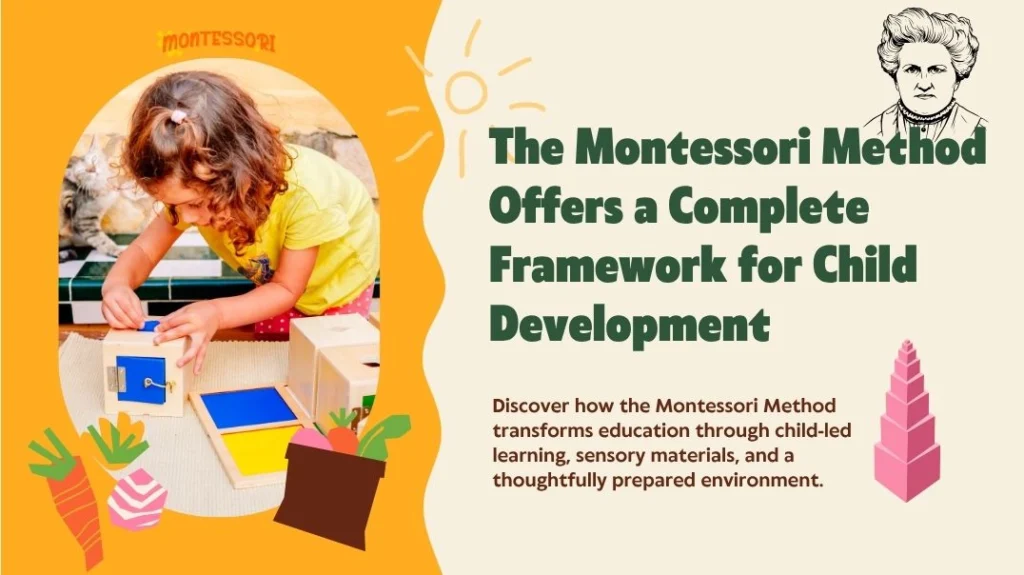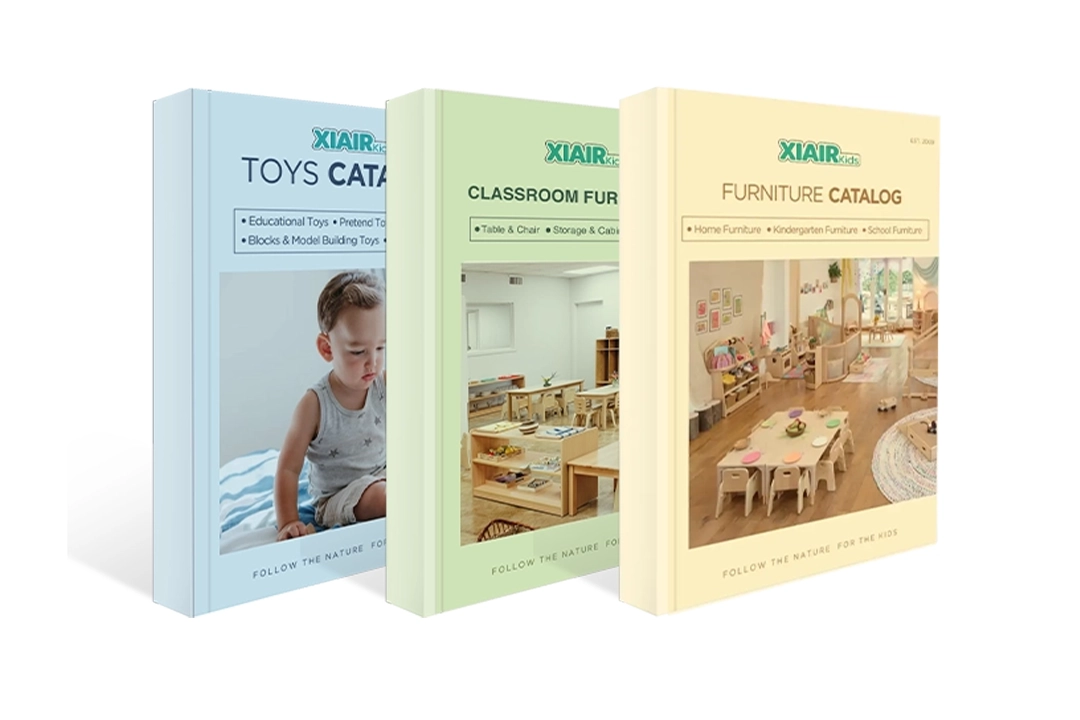Ein Bildungsmodell zu finden, das zur Entwicklung von Kindern passt, ist schwieriger als es sein sollte. Eltern erleben, wie ihre Kinder Konzentration, Interesse und Selbstvertrauen verlieren. Lehrer sind mit starren Systemen und eingeschränkter Flexibilität überfordert. Gleichzeitig lernt jedes Kind anders – manche schneller, manche langsamer, manche praxisorientiert, manche visuell – und die meisten traditionellen Klassenzimmer können da nicht mithalten.
Die Folge? Kinder, die sich unbeachtet fühlen, und Erzieher, die sich festgefahren fühlen. Lernen wird zur Routine, statt Entdeckungen zu machen. Kinder werden in Klassenstufen, Altersgruppen und Erwartungen eingeteilt, die selten widerspiegeln, wer sie wirklich sind. Die Lernumgebung wird zu etwas, das man durchstehen muss, statt darin zu wachsen.
Hier verändert die Montessori-Methode alles. Mit ihrer kindzentrierten Struktur, den praxisorientierten Materialien und der flexiblen Unterrichtsgestaltung ist die Montessori-Methode nicht nur ein weiterer Lehrplan – sie bietet ein umfassendes Rahmenwerk für entwicklungsorientiertes Lernen. Ob Sie eine Schule gründen, zu Hause unterrichten oder Ihren Unterricht neu gestalten – die Montessori-Methode bietet Ihnen eine Unterrichtsmethode, die endlich auf die Arbeitsweise von Kindern abgestimmt ist.
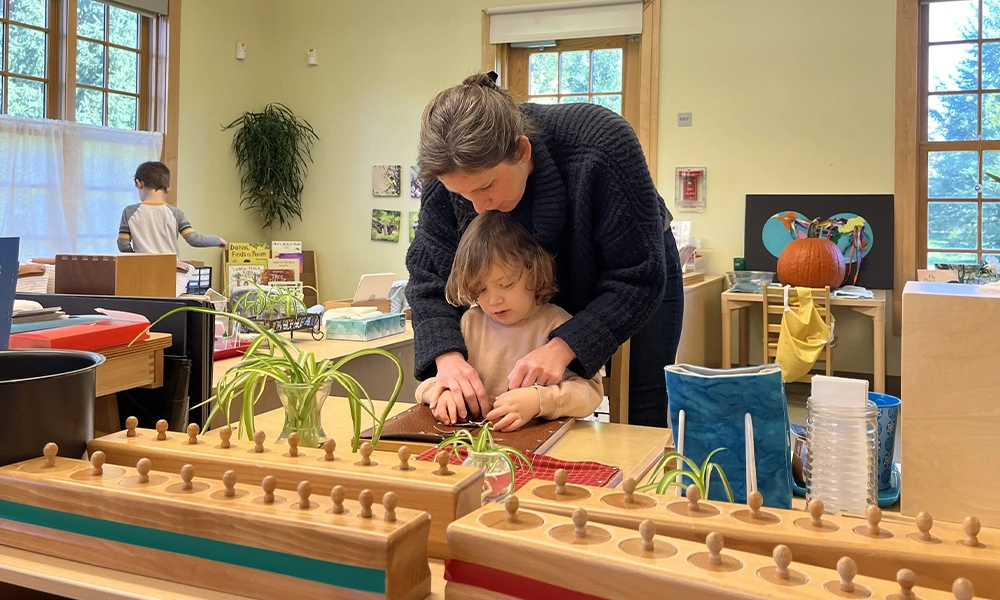
Einführung
Der Montessori-Methode ist ein weltweit anerkannter pädagogischer Ansatz, bei dem das Kind im Mittelpunkt steht und nicht das System. Diese Methode wurde im frühen 20. Jahrhundert von der italienischen Ärztin und Pädagogin Maria Montessori entwickelt und hat die kognitive, emotionale und soziale Entwicklung von Generationen von Kindern geprägt.
Im Kern basiert die Montessori-Methode auf dem Vertrauen in die natürliche Lernfähigkeit des Kindes. Sie legt Wert auf Unabhängigkeit, praktisches Lernen und sorgfältig vorbereitete Umgebungen, in denen Kinder in ihrem eigenen Tempo frei entdecken können. Lehrer fungieren eher als Begleiter denn als Lehrer, und Lernen wird zu einem Prozess des Entdeckens, nicht des Auswendiglernens.
Dieser Ansatz wirkt sich nicht nur auf die Testergebnisse aus – er verändert auch die Art und Weise, wie Kinder denken, Probleme lösen und mit der Welt interagieren. Diese Methode trägt maßgeblich dazu bei, wie sich das Gehirn entwickelt, wie Neugier gefördert und Selbstvertrauen aufgebaut wird.
In diesem Artikel erläutern wir die Prinzipien, Praktiken und nachhaltigen Auswirkungen der Montessori-Methode und untersuchen, wie sie effektiv in Klassenzimmern, zu Hause und im gesamten Schulsystem umgesetzt werden kann.
Maria Montessori und die Montessori-Methode – Pädagogik im Wandel
Maria Montessori war keine traditionelle Pädagogin. Sie begann ihre berufliche Laufbahn als Ärztin – sie war die erste Frau in Italien, die 1896 einen medizinischen Abschluss erlangte. Ihr wissenschaftlicher Hintergrund prägte ihre Sicht auf Bildung als einen Prozess, der auf Beobachtung, Experimenten und Respekt für die natürliche Entwicklung beruht.
Bei ihrer Arbeit mit Kindern, die als „unerziehbar“ galten, bemerkte sie etwas Revolutionäres: Mit den richtigen Materialien und der richtigen Umgebung konnten diese Kinder selbstständig und mit Freude lernen. Diese Entdeckung war der Grundstein für die spätere Montessori-Methode.
Anstatt ein Top-down-System zu entwickeln, das sich auf den Unterricht konzentriert, entwickelte Montessori eine Methode, die sich am Kind orientiert. Sie stellte fest, dass Kinder am besten lernen, wenn sie in einem sorgfältig vorbereiteten Raum frei wählen, sich bewegen und praktische Aktivitäten durchführen können. Die Montessori-Methode entstand als Reaktion auf diese Entdeckung – ein Weg, das volle Potenzial jedes Kindes zu entfalten, unabhängig von Herkunft und Fähigkeiten.
Ihr erstes Klassenzimmer, die Casa dei Bambini (Kinderhaus), wurde 1907 in Rom eröffnet. Es führte Konzepte ein, die später Montessori-Klassenzimmer weltweit prägen sollten: kindgerechte Möbel, offene Regale mit Lernmaterialien und Freiheit innerhalb der Grenzen. Diese Elemente waren nicht nur ästhetische Entscheidungen – sie waren Ausdruck von Montessoris Grundüberzeugung, dass die Umgebung dem Kind dienen sollte.
Montessoris Ideen verbreiteten sich schnell über Italien hinaus und beeinflussten Pädagogen in ganz Europa und Nordamerika. Als die Montessori-Methode internationale Aufmerksamkeit erlangte, wurde sie in öffentlichen und privaten Schulen, Gemeindezentren und sogar im häuslichen Umfeld übernommen.
Von der Beobachtung zur globalen Bewegung
Was die Montessori-Methode so einzigartig macht, ist ihre Grundlage in sorgfältiger Beobachtung und einem tiefen Respekt für die natürlichen Entwicklungsphasen des Kindes. Montessori hat keine Theorie aufgezwungen, sondern sie durch praktische Erfahrung entwickelt.
Heute, über ein Jahrhundert später, entwickelt sich ihre Methode kontinuierlich weiter, bleibt aber ihren Ursprüngen treu. Sie wird in über 140 Ländern angewendet und beweist, dass dieser kindzentrierte Ansatz weder an Kultur, Geografie noch Zeit gebunden ist. In einer Welt, in der Bildung oft starr und prüfungsorientiert erscheint, bietet die Montessori-Methode etwas grundlegend anderes: eine Bildungsmethode, die Kinder stärkt und ihre natürliche Lernweise respektiert.

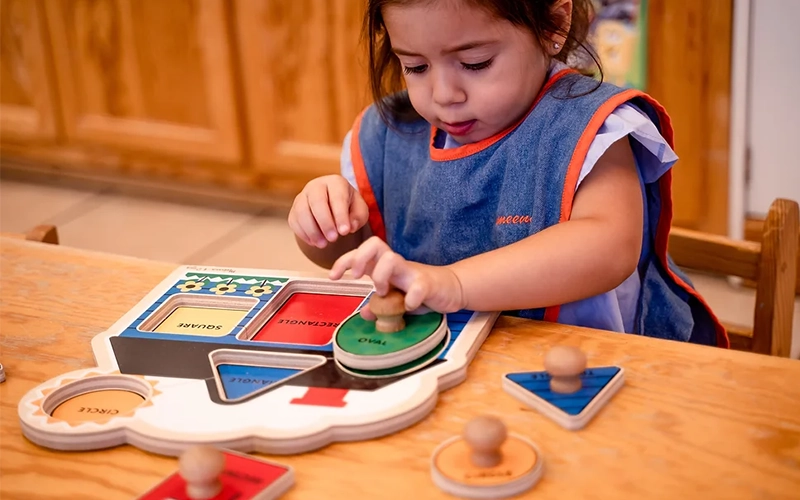
Was ist die Montessori-Methode? Eine klare Definition und Philosophie
Die Montessori-Methode ist ein kindzentrierter pädagogischer Ansatz, der Lernen als natürlichen, selbstgesteuerten Prozess betrachtet. Anstatt starren Unterricht oder standardisierte Tests zu verfolgen, ermutigt diese Methode Kinder, in ihrem eigenen Tempo zu forschen, zu hinterfragen und zu entdecken. Dieses Modell basiert auf Vertrauen – Vertrauen in die Fähigkeit des Kindes, seine Entwicklung im richtigen Umfeld selbst zu steuern.
Im Kern basiert die Montessori-Methode auf der Idee, dass sich die Erziehung an den natürlichen Wachstumsphasen orientieren sollte. Maria Montessori glaubte, dass Kinder von Natur aus neugierig und fähig sind und dass Pädagogen eher als Vermittler denn als Autoritäten fungieren sollten.
Kernmerkmale der Montessori-Methode
- Selbstgesteuertes Lernen
In einer Montessori-Einrichtung wählen Kinder ihre Aktivitäten aus einer Reihe von altersgerechten Optionen. Diese Freiheit stärkt das Selbstvertrauen, die Entscheidungsfähigkeit und die innere Motivation.
- Vorbereitete Umgebung
Der Klassenraum ist so gestaltet, dass er Selbstständigkeit und Bewegung fördert. Die Materialien sind auf gut zugänglichen Regalen angeordnet, und der Raum wirkt ruhig, ordentlich und einladend. Jedes Element erfüllt einen Zweck.
- Konkreter zu abstrakter Fortschritt
Kinder lernen durch die physische Manipulation von Materialien – durch Berühren, Bewegen und Experimentieren. Mit der Zeit bilden diese Erfahrungen die Grundlage für abstraktes Denken und Problemlösen.
- Klassenräume für mehrere Altersgruppen
Anstatt Kinder nach einem einzigen Alter zu gruppieren, erstreckt sich der Montessori-Unterricht über zwei bis drei Jahre. Jüngere Kinder lernen von älteren, und ältere Schüler festigen ihr Wissen durch Unterricht.
- Intrinsische Motivation statt externer Belohnungen
Es gibt keine goldenen Sterne oder Noten. Stattdessen entwickeln Kinder eine Liebe zum Lernen, indem sie die Freude an der Meisterschaft und an zielgerichteter Arbeit erleben.
Philosophische Grundlagen, die es auszeichnen
Bei der Montessori-Methode geht es nicht nur darum, wie Kinder lernen, sondern wie sie wachsen. Ihre Prinzipien basieren auf tiefem Respekt für die individuelle Entwicklung jedes Kindes. Montessori bezeichnete diesen Ansatz als „Hilfe zum Leben“, nicht nur als Bildung.
Im Gegensatz zu traditionellen Methoden, die Bildung als Input und Output betrachten, betrachtet die Montessori-Philosophie das Kind als aktiven Gestalter seines Geistes. Lernen geschieht durch Bewegung, Wiederholung und reale Erfahrungen, nicht durch passives Zuhören.
Indem die Montessori-Methode den Fokus auf das ganze Kind legt – kognitiv, emotional, körperlich und sozial – bereitet sie Kinder nicht nur auf die Schule, sondern auf das Leben vor.
Fünf Grundprinzipien des Erfolgs: Warum Montessori funktioniert
Der Erfolg der Montessori-Methode liegt in ihrer Fähigkeit, die pädagogische Praxis an der natürlichen Entwicklung von Kindern auszurichten. Anstatt eine Struktur von oben aufzuzwingen, baut dieser Ansatz Lernumgebungen auf, die sich an den Bedürfnissen, Neigungen und Fähigkeiten des Kindes orientieren. Im Mittelpunkt der Montessori-Methode stehen fünf Grundprinzipien, die alles von der Klassenzimmergestaltung bis zum Tagesablauf prägen.
Diese Grundprinzipien sind keine abstrakten Theorien – sie sind beobachtbar, praktisch und haben sich in verschiedenen Kulturen und Altersgruppen bewährt. Lassen Sie uns sie einzeln untersuchen.
1. Respekt vor dem Kind
Die Montessori-Methode geht von der Idee aus, dass Kinder den gleichen Respekt verdienen wie Erwachsene. Respekt bedeutet in diesem Zusammenhang mehr als höfliches Verhalten; er bedeutet, das Bedürfnis des Kindes nach Autonomie, seine Entscheidungsfähigkeit und seinen inneren Lerndrang zu respektieren.
In einer Montessori-Klasse spiegelt sich dieser Respekt in jeder Interaktion wider. Lehrer unterbrechen ein konzentriertes Kind nicht. Kinder werden nicht gezwungen, sich an einen Einheitsplan zu halten. Stattdessen erhalten sie Raum und Zeit, in ihrem eigenen Tempo zu wachsen, und ihre Stimme ist Teil des Lernprozesses.
2. Der absorbierende Geist
Maria Montessori stellte fest, dass Kinder zwischen der Geburt und dem sechsten Lebensjahr über einen „absorbierenden Geist“ verfügen. Das bedeutet, dass sie auf natürliche Weise und ohne bewusste Anstrengung Informationen aus ihrer Umgebung aufnehmen, ähnlich wie ein Schwamm.
Der Montessori-Methode nutzt diese starke mentale Verfassung, indem es eine sinnliche Umgebung voller Sprache, Ordnung, Bewegung und Kultur bietet. Die Materialien sind so gestaltet, dass sie die Sinne ansprechen und zum Entdecken anregen. Dank der Aufnahmefähigkeit des Gehirns können selbst komplexe Themen wie Mathematik, Sprache und Geographie bereits in überraschend jungem Alter ohne Stress und Auswendiglernen vermittelt werden.
3. Empfindliche Perioden
In bestimmten Zeiträumen sind Kinder besonders empfänglich für das Erlernen bestimmter Fähigkeiten. Diese sogenannten „sensiblen Phasen“ sind besonders empfänglich für das Erlernen bestimmter Fähigkeiten. Beispielsweise kann ein Kind plötzlich ein starkes Interesse an Buchstaben, Einschenken oder sozialen Interaktionen zeigen.
Die Montessori-Methode ignoriert diese Phasen nicht, sondern geht gezielt darauf ein. Ein Montessori-Betreuer beobachtet jedes Kind genau und stellt Materialien oder Unterrichtseinheiten vor, die seinen aktuellen Interessen entsprechen. So wird sichergestellt, dass sich das Lernen natürlich und befriedigend anfühlt und nicht erzwungen oder frustrierend.
4. Die vorbereitete Umgebung
Ein Kennzeichen der Montessori-Methode ist die Betonung der Umgebung als aktiver Teil des Lernprozesses. Montessori-Klassenzimmer sind sorgfältig gestaltete Räume, in denen alles seinen Zweck und seinen Platz hat.
Die Möbel sind kindgerecht. Die Regale sind offen und die Materialien geordnet angeordnet. Beleuchtung, Farben, Geräusche und sogar Pflanzen sind so gewählt, dass sie Konzentration und Ruhe fördern. Die Umgebung bietet dem Kind in gewissen Grenzen Freiheit – sie lädt zum Entdecken ein, lehrt aber auch Ordnung, Verantwortung und Selbstkontrolle.
In vielerlei Hinsicht ist die vorbereitete Umgebung neben dem Erwachsenen und dem Kind der „dritte Lehrer“ in der Montessori-Pädagogik.
5. Auto-Education (Selbst-Education)
Der vielleicht revolutionärste Aspekt der Montessori-Methode ist ihre Überzeugung, dass Kinder in der Lage sind, sich selbst zu bilden. Mit den richtigen Materialien, der richtigen Umgebung und respektvoller Anleitung streben Kinder ganz natürlich nach Wissen.
Autodidaktik bedeutet nicht, dass Kinder allein lernen – es bedeutet, dass das Lernen von innen kommt. Dieses Prinzip befähigt die Lernenden, Unabhängigkeit, Resilienz und eine lebenslange Entdeckerfreude zu entwickeln.
Auch die Rolle des Erwachsenen verändert sich. Statt als Autorität zu agieren, die Wissen vermittelt, wird der Montessori-Betreuer zum Beobachter, Förderer und Gestalter von Lernmöglichkeiten.
Diese fünf Prinzipien bilden das philosophische und praktische Rückgrat der Montessori-Methode. Sie sind nicht nur Ideen – sie sind Handlungen, Gewohnheiten und Strategien, die sich in jedem Aspekt des Montessori-Lernens widerspiegeln. Sie erklären, warum diese Methode auch mehr als ein Jahrhundert nach ihrer Entstehung noch immer relevant ist – und warum sie weiterhin Klassenzimmer und Lernende auf der ganzen Welt verändert.

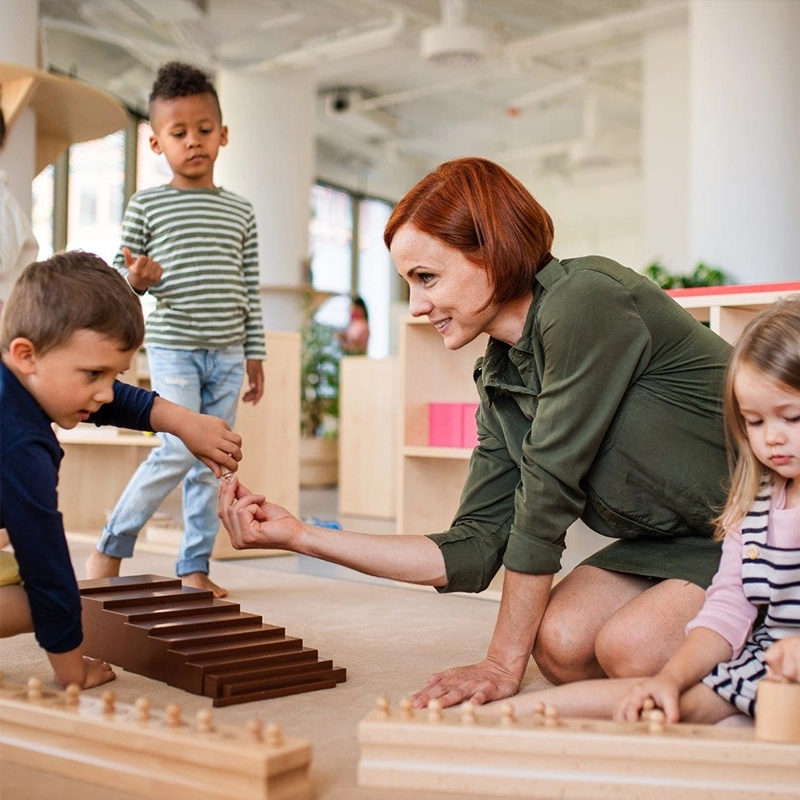
Montessori-Klassenzimmergestaltung: Die vorbereitete Umgebung in Aktion
Eines der wirkungsvollsten Elemente der Montessori-Methode ist die Idee, dass die Umgebung nicht nur eine Kulisse für das Lernen ist – sie ist ein aktiver Teilnehmer. In einem gut gestalteten Montessori-Klassenzimmer dient alles einem Zweck, und jedes Detail ist bewusst gewählt. Dies nannte Maria Montessori die vorbereitete Umgebung.
Wenn Kinder einen Montessori-Raum betreten, sollten sie sich ruhig, neugierig und selbstbewusst fühlen. Die räumliche Gestaltung fördert Bewegungsfreiheit, selbstständiges Erkunden und soziale Interaktion – und das alles in einer geordneten, schönen und funktionalen Umgebung.
Um eine vollständige Übersicht darüber zu erhalten, wie man ein authentisches Montessori-Klassenzimmer aufbaut, lesen Sie unseren speziellen Leitfaden auf Montessori-Klassenzimmergestaltung.
Hauptmerkmale einer vorbereiteten Montessori-Umgebung
Kindergerecht und zugänglich
In einem Montessori-Klassenzimmer werden die Möbel speziell für das Kind gebaut. Sie sind nicht einfach nur kleinere Versionen von Möbeln für Erwachsene, sondern durchdacht proportioniert, um Unabhängigkeit und Komfort zu fördern. Wenn Kinder selbstständig sitzen, Regale ohne Hilfe erreichen und Materialien frei bewegen können, fühlen sie sich selbstbewusster und leistungsfähiger.
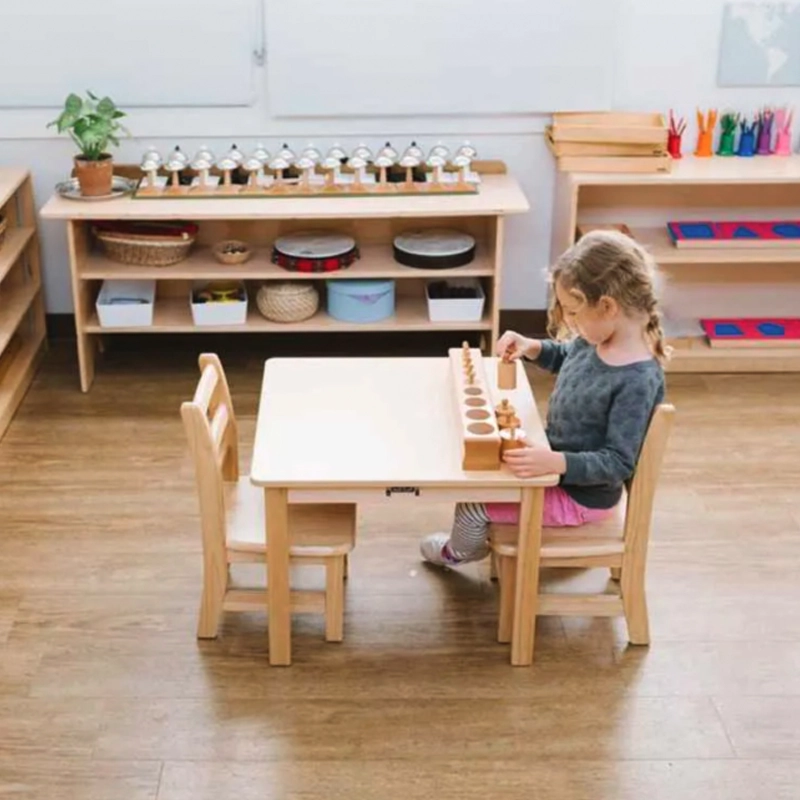
Empfohlene Produkte:
- Offene Ablagefächer für individuelle Arbeitsmaterialien
- Tische und Stühle aus Massivholz in Kindergröße (für 3–6 und 6–12 Jahre)
- Höhengerechte Regale mit abgerundeten Ecken
Definierte Lernzonen
Jeder Bereich des Klassenzimmers dient einer entwicklungsfördernden Funktion. Praktische, sensorische, mathematische, sprachliche und kulturelle Aktivitäten sind getrennt, um kognitive Überlastung zu reduzieren und die Konzentration der Kinder zu fördern. Diese Zonen sind nicht durch Schilder, sondern durch räumliche Hinweise und Materialplatzierung gekennzeichnet.
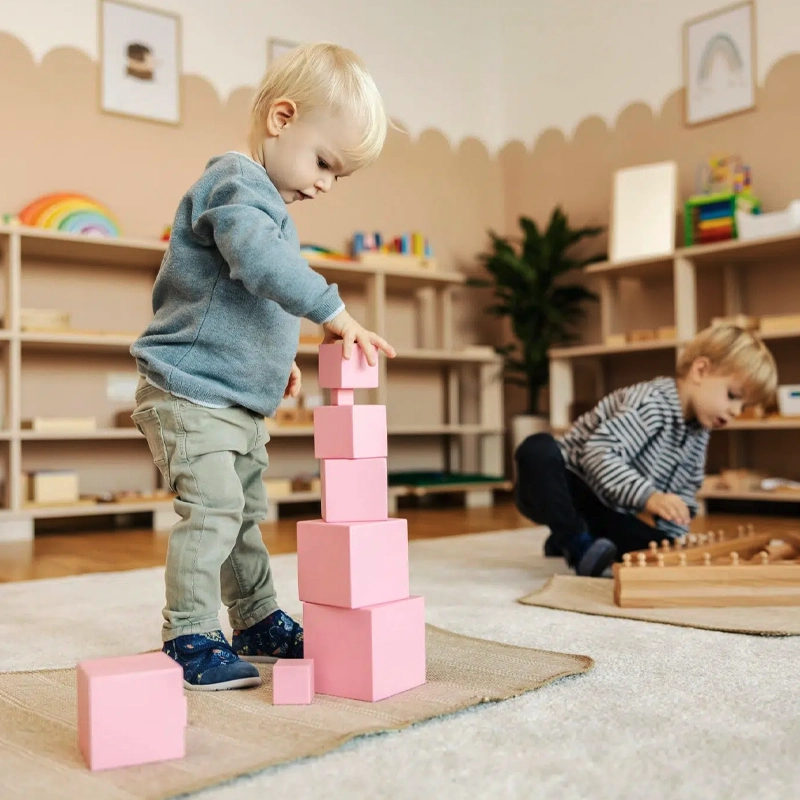
Empfohlene Produkte:
- Materialspezifische Möbel (z. B. Handwaschtische, Perlenschränke, bewegliche Alphabetschubladen)
- Modulare Regaleinheiten zur Unterteilung von Lernbereichen
- Arbeitsmatten oder Teppiche zur optischen Abgrenzung von Arbeitsbereichen auf dem Boden
Minimalistisches und zweckmäßiges Design
Montessori-Klassenzimmer sind ruhig, geordnet und zielstrebig. Materialien werden ansprechend, aber nicht dekorativ präsentiert – jedes Objekt ist zum Anfassen, Erkunden und Benutzen da. Es gibt keine Unordnung oder Reizüberflutung.
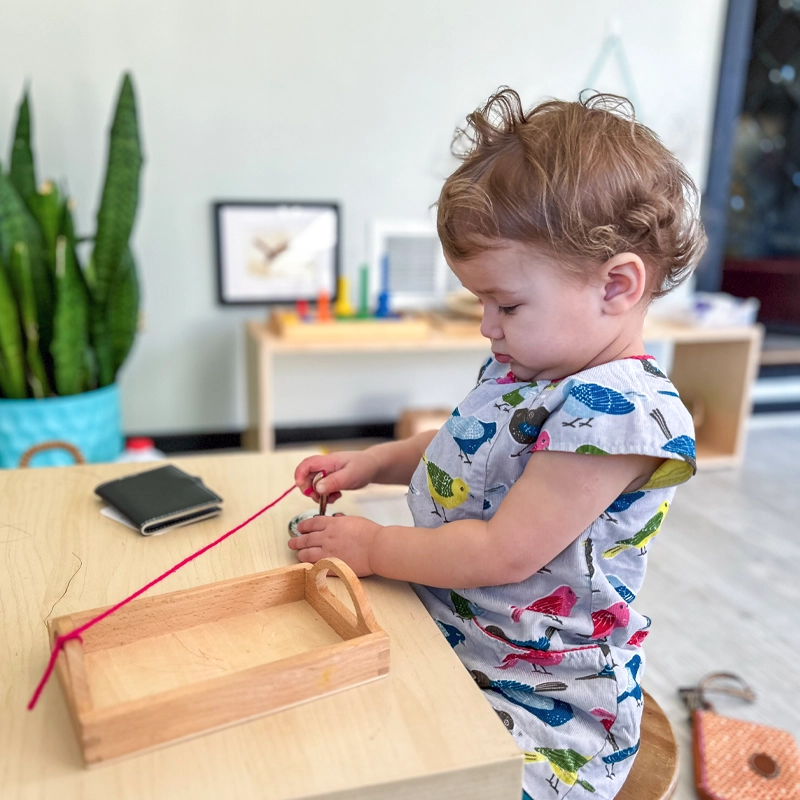
Empfohlene Produkte:
- Praktische Lebenswerkzeuge: Keramikkrüge, Holztabletts, echte Utensilien
- Möbel in Naturoptik (Birke, Buche, Ahorn)
- Stellen Sie Staffeleien für von Kindern geschaffene Kunstwerke auf
Freiheit innerhalb der Struktur
Der Raum lädt Kinder zum Entdecken ein, aber nicht zum wahllosen Erkunden. Die räumliche Anordnung lenkt die Bewegung und fördert die Eigenverantwortung. Alles hat seinen Platz, und jeder Platz hat seinen Grund.
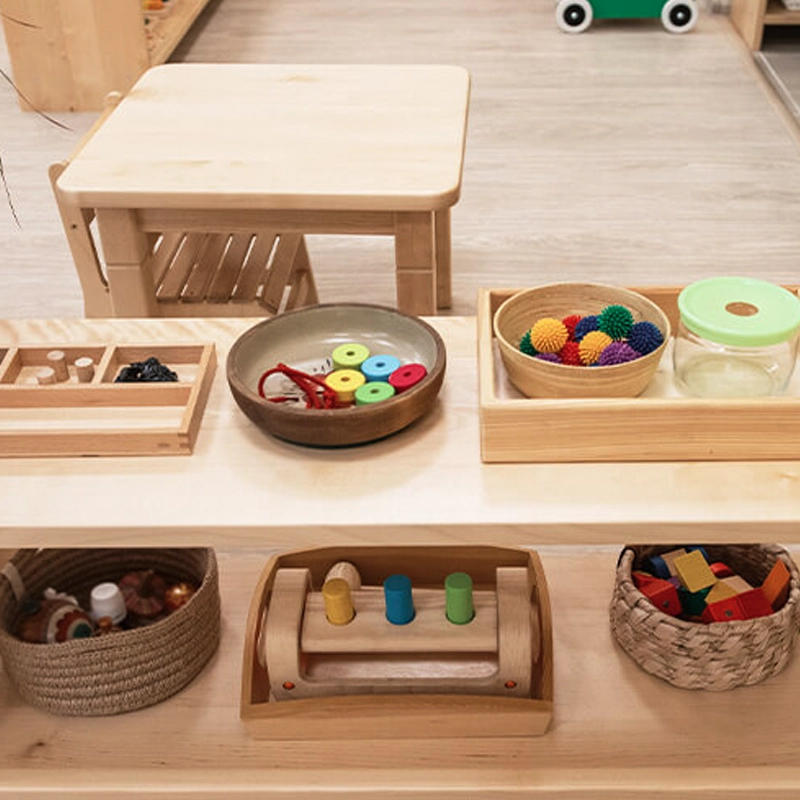
Empfohlene Produkte:
- Offene Ausstellungseinheiten, sortiert nach Thema, Schwierigkeitsgrad und Nutzungsreihenfolge
- Aufbewahrungskörbe und -tabletts mit klar zugeordneten Fächern
- Individuelle Regale, die der Reihenfolge der Montessori-Materialien entsprechen
Wie Design die Montessori-Prinzipien verstärkt
Die vorbereitete Umgebung ist ein physischer Ausdruck der zuvor besprochenen Montessori-Prinzipien, insbesondere Respekt, Unabhängigkeit und Freiheit innerhalb von Grenzen.
- Respekt für das Kind zeigt sich darin, wie die Materialien auf ihrer Ebene platziert werden.
- Unabhängigkeit wird durch zugängliche Werkzeuge und offene Räume gefördert.
- Selbstbildung wird durch die logische Abfolge der Materialien und die Übersichtlichkeit der Anordnung ermöglicht.
Indem die Montessori-Methode Kindern freies Handeln in einem durchdachten, strukturierten Raum ermöglicht, gibt sie ihnen die absolute Kontrolle über ihr Lernerlebnis. Diese Befähigung stärkt das Selbstvertrauen, die Konzentration und die Freude am Lernen – Eigenschaften, die im traditionellen Unterricht nur schwer zu fördern sind.
Produktanwendung: Ein Montessori-Klassenzimmer mit Sinn schaffen
Egal, ob Sie eine Schule eröffnen oder einen einzelnen Raum zu Hause umgestalten, die Gestaltung einer vorbereiteten Montessori-Umgebung erfordert mehr als nur ästhetische Entscheidungen – sie erfordert Absicht.
Hier kommen unsere maßgeschneiderten Montessori-Möbel und Klassenzimmerlösungen ins Spiel. Wir bieten kindgerechte Tische, offene Regale, Arbeitsteppiche und ausgewählte Materialsets, die genau den Prinzipien der Montessori-Methode entsprechen. Jedes Möbelstück ist langlebig, entwicklungsgerecht und altersgerecht.
Der Aufbau einer vorbereiteten Umgebung muss nicht überwältigend sein. Mit den richtigen Werkzeugen wird es zu einer Gelegenheit, einen Raum zu gestalten, in dem Kinder auf natürliche Weise gedeihen und die Montessori-Pädagogik in jeder Ecke lebendig wird.
Träumen Sie nicht nur davon, entwerfen Sie es! Lassen Sie uns über Ihre individuellen Möbelwünsche sprechen!
Praktisches Lernen: Sensorische Materialien, Sprach- und Mathematik-Tools
Eines der prägendsten Merkmale der Montessori-Methode ist die Betonung des taktilen, praktischen Lernens. Montessori-Klassenzimmer sind mit sorgfältig gestalteten Materialien ausgestattet, die die Kinder direkt bearbeiten und ihnen ermöglichen, abstrakte Konzepte durch körperliche Erfahrung zu verinnerlichen.
Diese Materialien sind kein Spielzeug – sie sind Werkzeuge zum Entdecken. Jedes Material verfolgt einen klaren pädagogischen Zweck und führt jeweils ein Konzept ein. Ihre Struktur, Beschaffenheit und Entwicklung basieren auf Montessoris tiefem Verständnis davon, wie Kinder Wissen vom Konkreten zum Abstrakten aufbauen.
Lassen Sie uns untersuchen, wie die Montessori-Methode das Lernen durch sensorische, sprachliche und mathematische Materialien zum Leben erweckt – und wie die richtigen Werkzeuge den Lernweg jedes Kindes verbessern können.
Sensorische Materialien: Wahrnehmung schärfen durch Berührung und Ordnung
Die sensorische Arbeit ist grundlegend für die Montessori-Pädagogik. Diese Materialien verfeinern die Fähigkeit eines Kindes, die Welt klarer zu sehen, zu hören, zu berühren, zu schmecken und zu riechen. Sie helfen Kindern auch, Eigenschaften wie Größe, Farbe, Gewicht, Textur und Temperatur zu kategorisieren und zu vergleichen.
Beispiele für wichtige sensorische Materialien:
- Rosa Turm – entwickelt visuelle Größenunterscheidung und räumliches Bewusstsein
- Knopfzylinder – schult die Feinmotorik und die Differenzierung von Dimensionen
- Farbtabletten – Verbesserung der Farberkennung und Abstufungsanpassung
- Resonanzkörper – schärfen die auditive Wahrnehmung und das Gedächtnis
- Raue und glatte Bretter – taktile Sensibilität und Wortschatz aufbauen
Empfohlene Produkte:
- Komplette sensorische Materialsets für Kinder im Alter von 3–6 Jahren
- Farbcodierte Lagerregale für sensorische Sequenzen
- Ausstellungsständer für den Unterricht zum Organisieren und Präsentieren taktiler Materialien
Weitere Informationen finden Sie in unserem vollständigen Leitfaden zu Montessori-Sensorikmaterialien
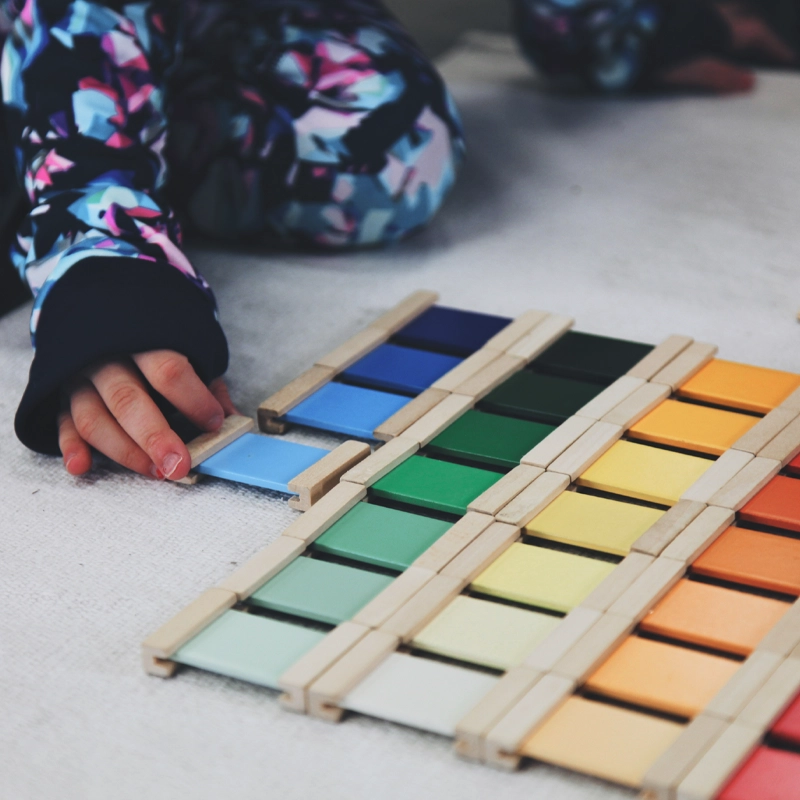
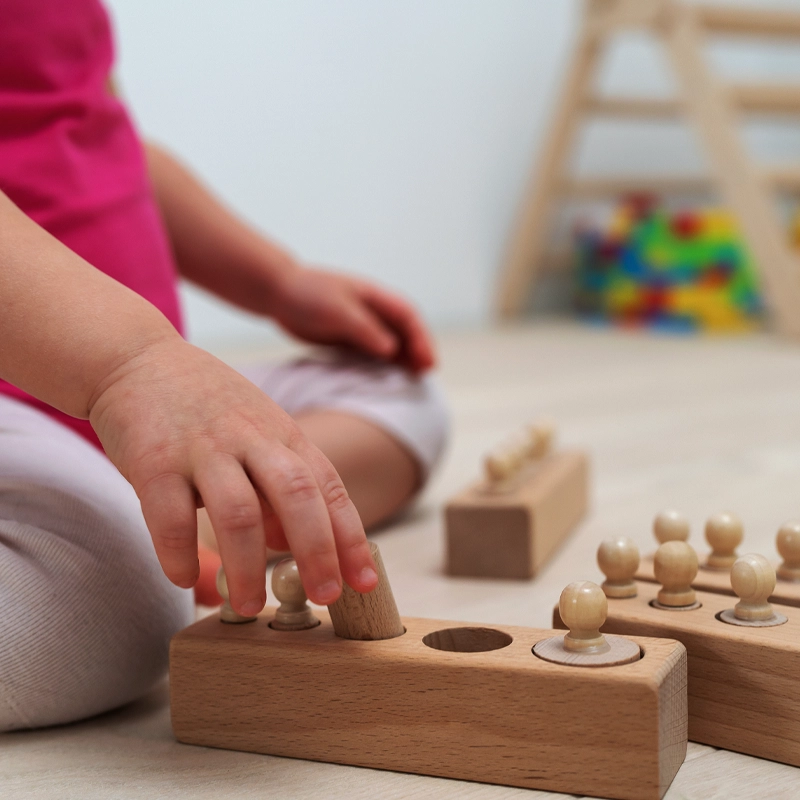
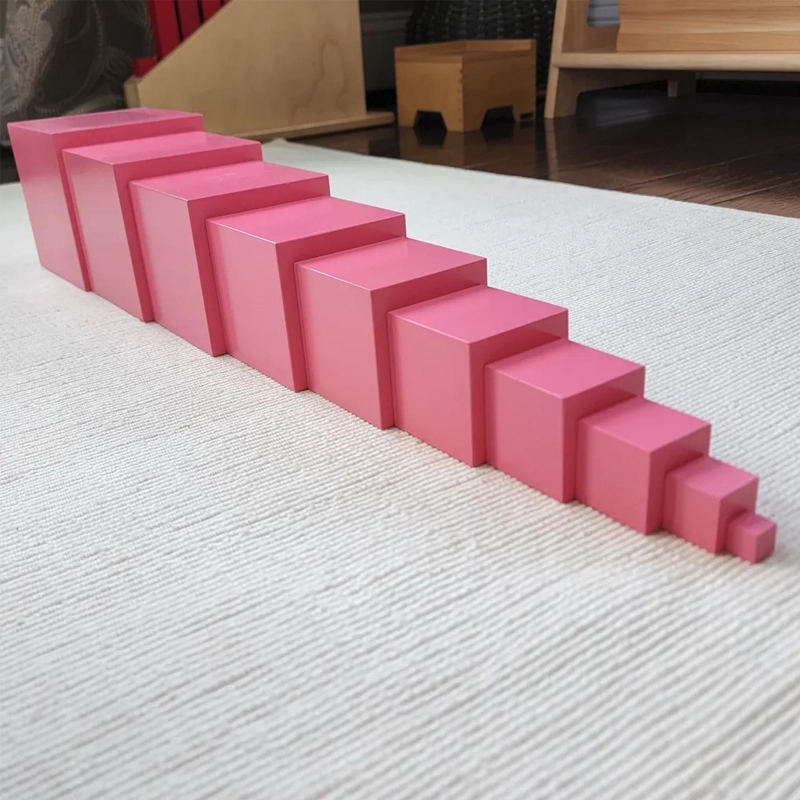
Sprachmaterialien: Lese- und Schreibkompetenz vom Laut zum Symbol
Der Montessori-Methode betrachtet Sprache als eine Entwicklungsreise – vom gesprochenen Wort über die Lautwahrnehmung bis hin zum Lesen und Schreiben. Kinder lernen nicht durch das Auswendiglernen von Buchstaben, sondern indem sie sie fühlen, ihre Laute hören und sie zur Bedeutungsbildung verwenden.
Zu den wichtigsten Sprachtools gehören:
- Sandpapierbuchstaben – Kinder fahren Buchstaben mit ihren Fingern nach und lernen dabei die dazugehörigen Laute
- Bewegliches Alphabet – ermöglicht es Kindern, Wörter phonetisch zu bilden, bevor sie schreiben können
- Metalleinsätze – Entwicklung der Stifthaltung, Formkontrolle und Vorbereitung auf das Schreiben
- Sprachobjektsätze – für die Zuordnung von Lauten und Objekten und die Erweiterung des Wortschatzes
Empfohlene Produkte:
- Sprachlernmaterial-Sets (Altersgruppen 3–6, 6–9)
- Robuste, bewegliche Alphabet-Tabletts mit Groß- und Kleinbuchstaben
- Buchstabentafeln aus Sandpapier in Schreib- oder Druckformat
- Metalleinbau-Anzeigestationen und Arbeitsblätter zur Feinmotorik
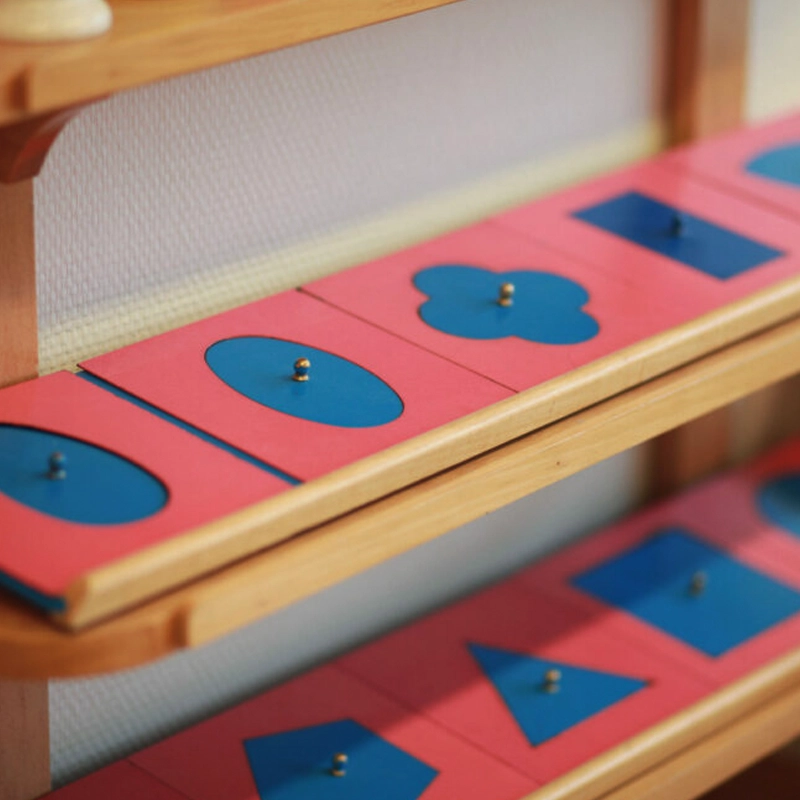
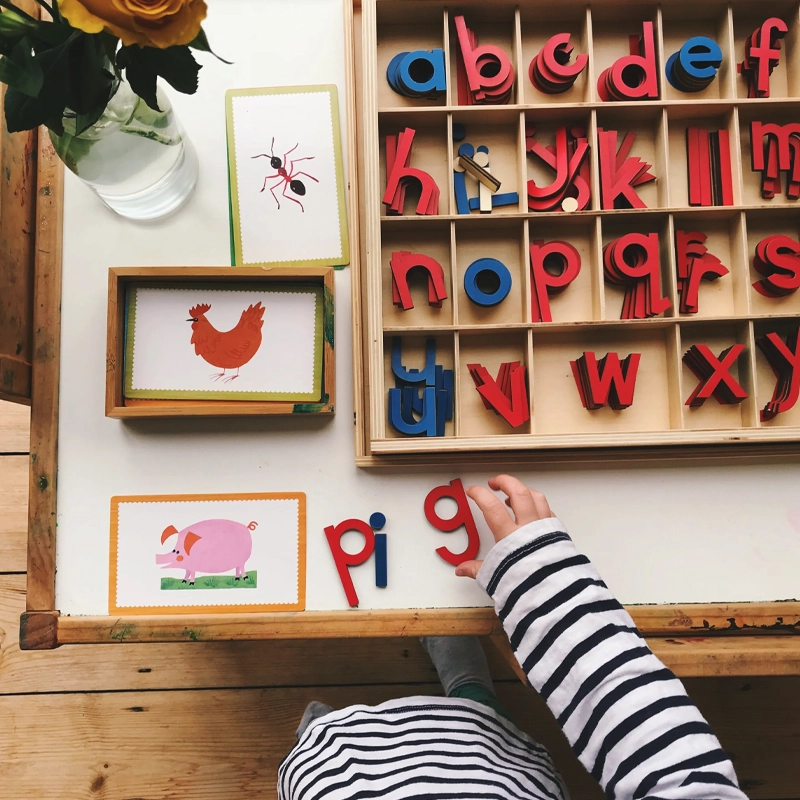
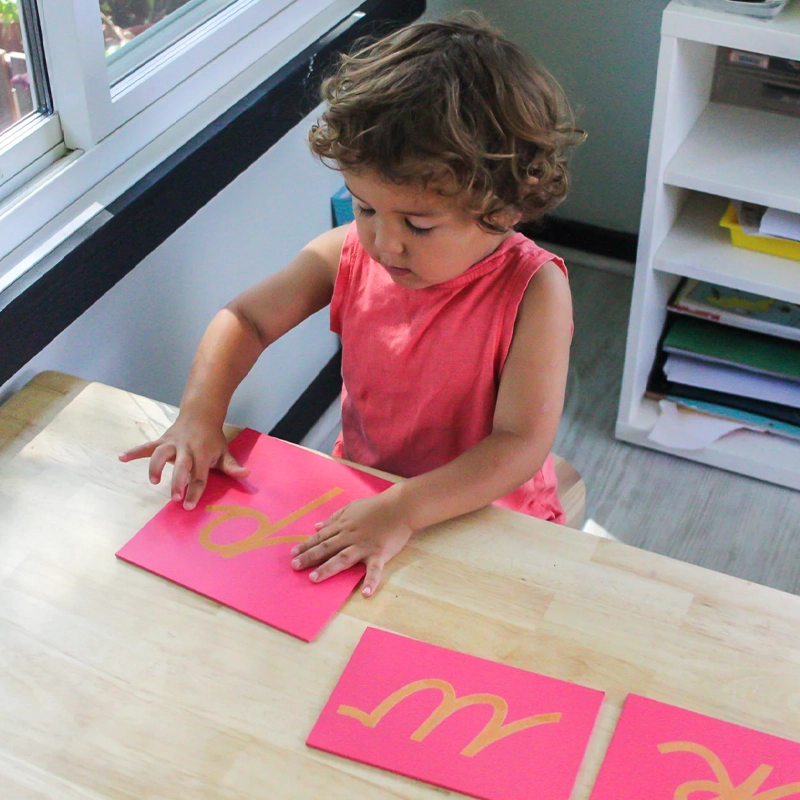
Mathematikmaterialien: Zahlen greifbar und logisch machen
Mathematik in der Montessori-Methode ist von Anfang an praxisorientiert. Kinder entwickeln zunächst durch körperliche Manipulation ein Verständnis für Mengen und Zahlen. Abstrakte Symbole und Operationen werden erst eingeführt, wenn das Konzept durch Berührung und Bewegung verinnerlicht wurde.
Wichtige Montessori-Mathematikmaterialien:
- Zahlenstäbe – Zählen, Größensequenzierung und das Konzept der Menge lehren
- Goldene Perlen – Einführung in das Dezimalsystem und in Rechenoperationen (Addition, Subtraktion usw.)
- Stempelspiel – macht Stellenwerte und Berechnungen anschaulicher
- Perlenketten – Kindern helfen, das Zählen in Schritten, die Multiplikation und das Quadrieren zu verstehen
- Brucheinschübe – Teile eines Ganzen und grundlegende Geometrie einführen
Empfohlene Produkte:
- Vollständiges Mathematik-Materialset mit Fortschrittskarte (Alter 3–12)
- Perlenschranksysteme für Goldperlen und Perlentreppen
- Montessori-Dezimalmaterialien mit farbcodierten Tabletts
- An das Lernniveau angepasste Mathematikstationen im Klassenzimmer
Für eine vollständige Abfolge der Zahlenarbeit besuchen Sie unsere Montessori-Mathematikmaterialien
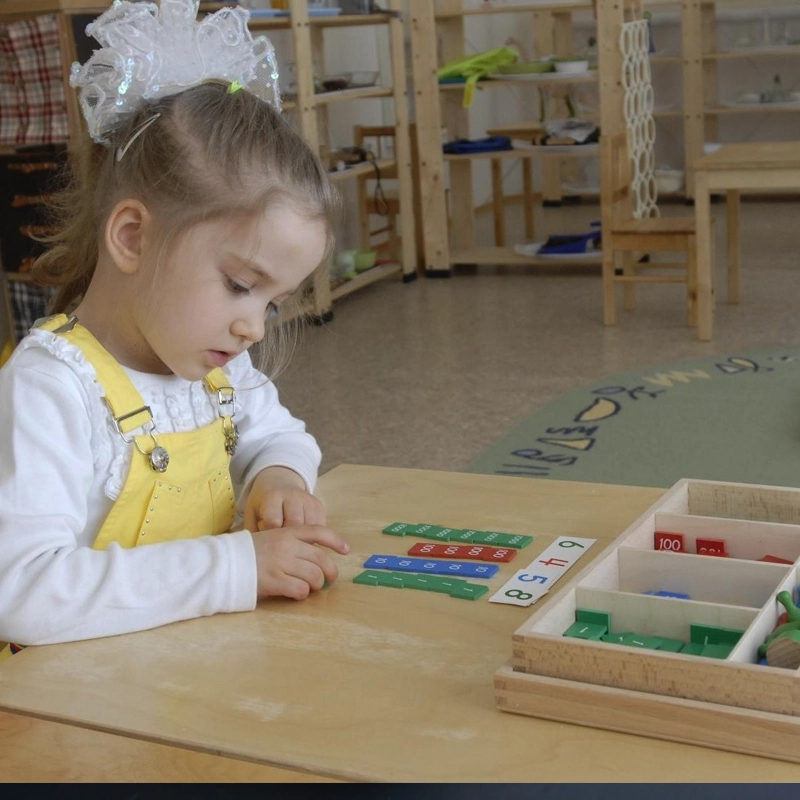
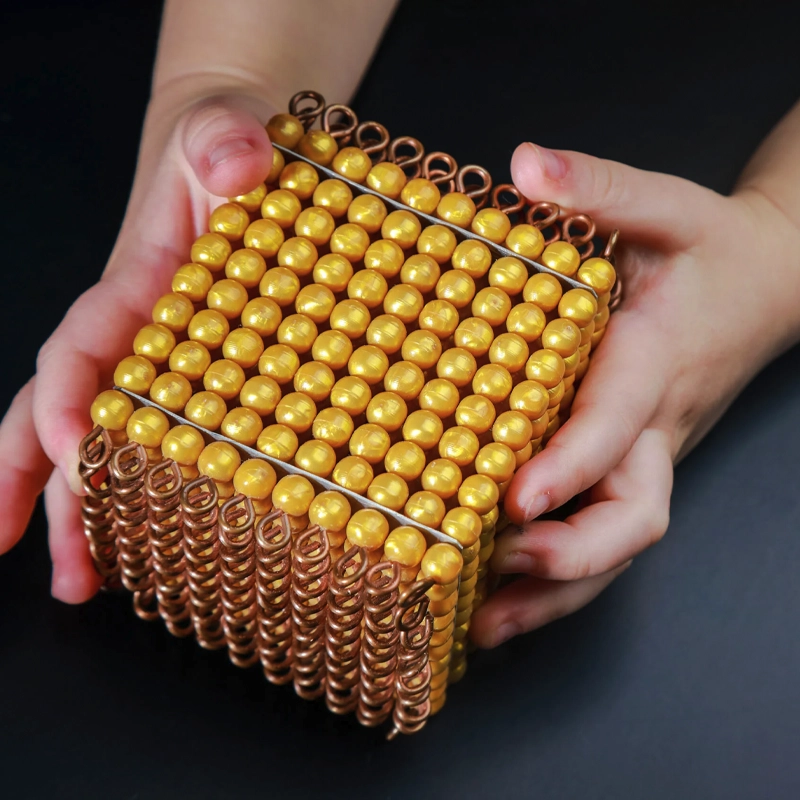
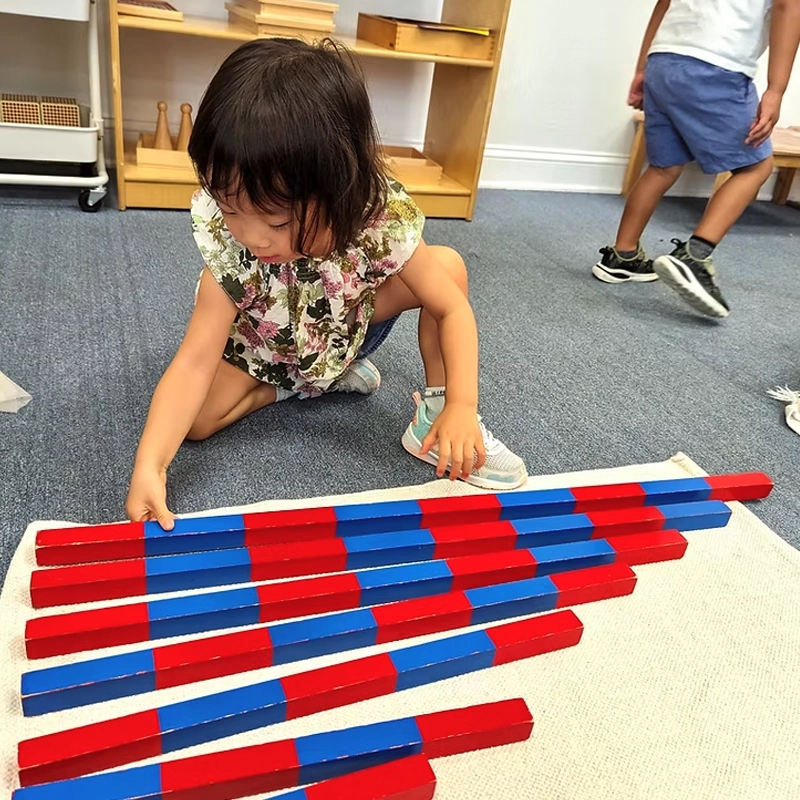
Vom Material zur Meisterleistung: Warum Qualitätswerkzeuge wichtig sind
Montessori-Materialien sind nur dann effektiv, wenn sie langlebig, sorgfältig gestaltet und entwicklungsgerecht sind. Billige Nachbildungen oder unvollständige Sets unterbrechen den Lernprozess und verringern die Fähigkeit des Kindes zur Selbstkorrektur oder zum selbstständigen Entdecken.
Wir bieten eine kuratierte Auswahl an sensorischen, sprachlichen und mathematischen Hilfsmitteln, die den ursprünglichen Designstandards von Montessori entsprechen. Unsere Materialien bestehen aus kindersicherem Holz, sind zur besseren Übersichtlichkeit farbcodiert und in regalfertigen Formaten angeordnet.
Ganz gleich, ob Sie ein neues Klassenzimmer einrichten oder vorhandene Materialien aufrüsten, wir können Ihnen dabei helfen, eine vollständige und authentische praktische Lernumgebung aufzubauen, die auf dem bewährten Erfolg der Montessori-Methode basiert.
Unterstützung über das Studium hinaus: Praktisches Leben und inklusives Lernen
Materialien für das praktische Leben: Grundlage für Unabhängigkeit
In der Montessori-Methode bilden praktische Aktivitäten den wesentlichen Ausgangspunkt der Erziehung. Sie entwickeln bei Kindern Unabhängigkeit, motorische Koordination, Konzentration und Verantwortungsbewusstsein – Fähigkeiten, die weit über das schulische Lernen hinausgehen.
Bildungsziele
- Fördern Sie die Beherrschung täglicher Selbstpflegeroutinen wie Anziehen, Essen und Aufräumen.
- Schaffen Sie Ordnung und Führungsfunktionen durch die sequentielle Erledigung von Aufgaben
- Bereiten Sie die Hände durch wiederholte feinmotorische Bewegungen auf das Schreiben vor
Empfohlene Materialien und Klassenzimmergestaltung
| Materialtyp | Zweck | Einrichtungsvorschläge |
|---|---|---|
| Gießsets (Keramik/Glas) | Verbessert die Hand-Auge-Koordination | Einsatz auf rutschfesten Tabletts, mit leicht erreichbaren Ablagen |
| Reinigungssets (Besen, Mopp, Tuch) | Vermittelt Verantwortung und Routine | Hängen Sie Werkzeuge mit wandmontierten Organizern in Kinderhöhe auf |
| Kleiderrahmen (Knöpfe, Reißverschlüsse) | Verfeinert die Feinmotorik | Präsentation auf offenen Regalen mit mehreren Ebenen zur Selbstauswahl |
| Kindersichere Küchengeräte | Einführung in die Lebensmittelzubereitung und Hygiene | Integrieren Sie den Lebensmittelbereich mithilfe farbcodierter Behälter |
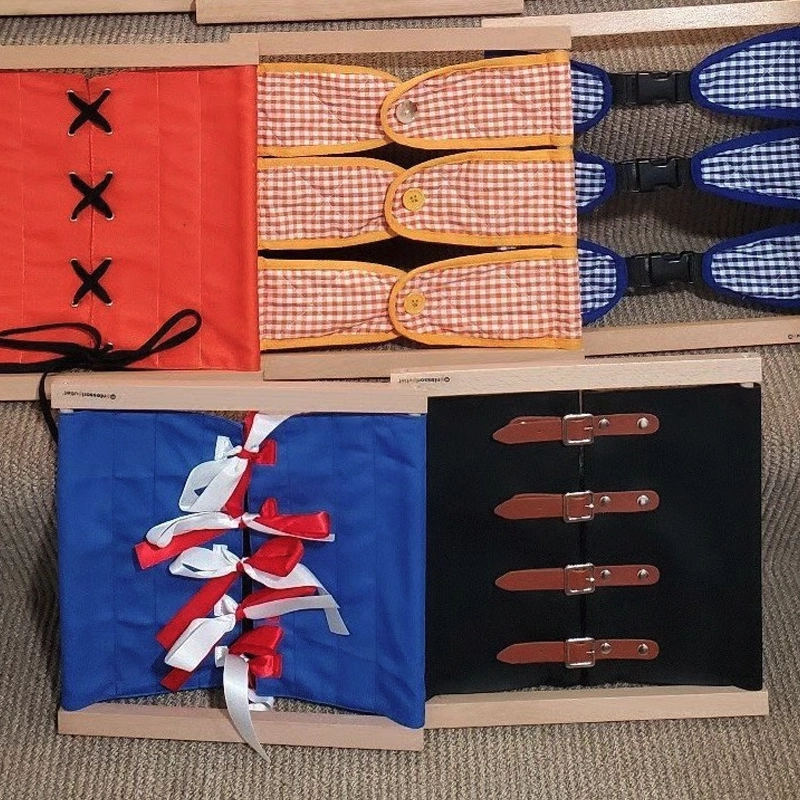
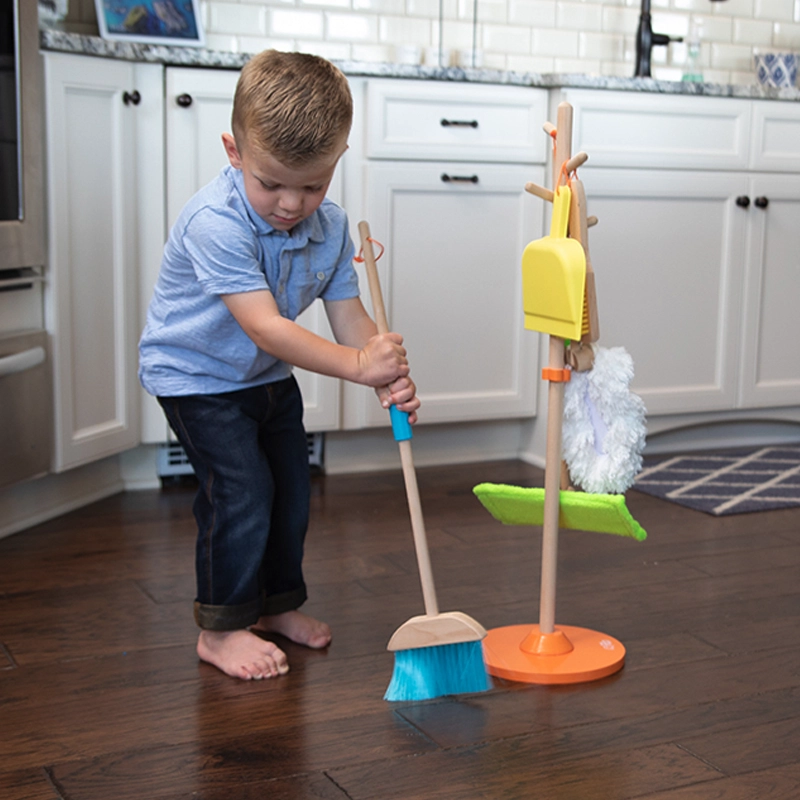
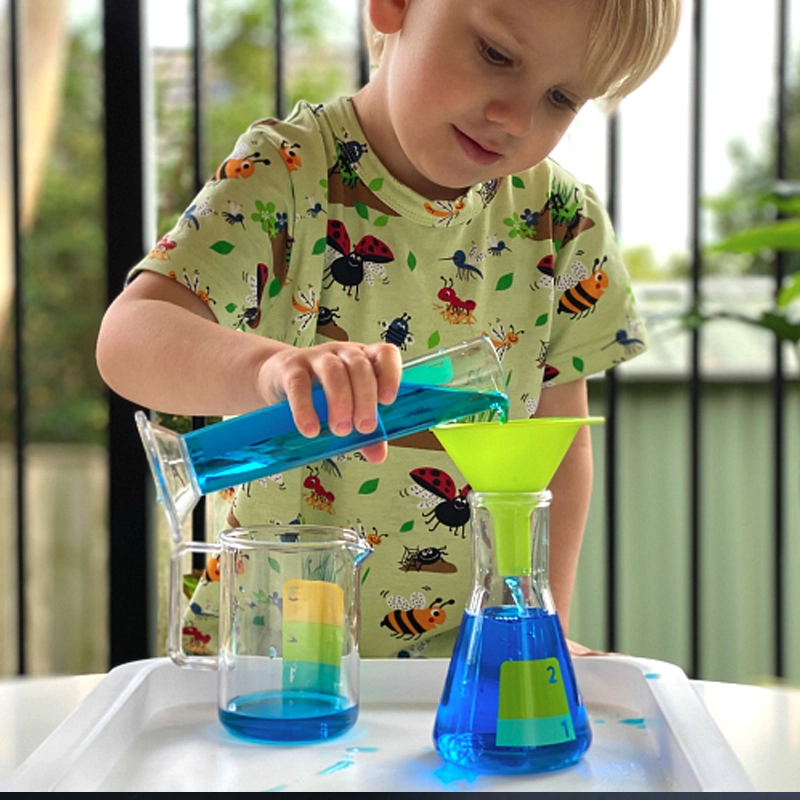
Tipps zur Implementierung
- Wechseln Sie die Aufgaben wöchentlich, um das Interesse und die Abwechslung bei den Fähigkeiten aufrechtzuerhalten
- Stellen Sie sicher, dass Kinder jede Aufgabe von Anfang bis Ende selbstständig erledigen können
- Vermeiden Sie Plastikimitationen – verwenden Sie grundlegende, verkleinerte Werkzeuge, die Respekt und Zweckmäßigkeit vermitteln
Eine vollständige Aufschlüsselung der Materialien und Strategien finden Sie in unserem Leitfaden zu Montessori Materialien für das praktische Leben.
Inklusives Lernen: Erfüllung unterschiedlicher Entwicklungsbedürfnisse
Die Montessori-Methode bietet einen einzigartig anpassungsfähigen Rahmen für die Unterstützung neurodiverser Lerner, einschließlich Kindern mit Autismus, ADHS oder sensorischen Verarbeitungsstörungen. Der Fokus auf selbstbestimmtes, praxisorientiertes Engagement macht sie von Natur aus inklusiv.
Unterrichtsprinzipien
- Passen Sie sich unterschiedlichen Energieniveaus, Aufmerksamkeitsspannen und sensorischen Schwellen an
- Reduzieren Sie Verhaltensauslöser durch konsistente Umgebungen
- Bieten Sie Tools zur emotionalen Regulierung und Aufgabenwiederholung an
Empfohlene Materialien
- Visuelle Aufgabentafeln mit Bildsequenzen für nonverbale Lerner
- Gewichtete Schoßpolster oder Sitzkissen für Erdung und Körperbewusstsein
- Doppelte Arbeitsstationen zur Unterstützung wiederholter Übungen
- Mobile Ruhezonen mit geräuschreduzierenden Möbeln oder Stofftrennwänden
Designstrategien
- Integrieren Sie eine „Neurodiversitätsecke“ für individuelles Lernen
- Verwenden Sie gedämpfte Farben und nicht reflektierende Oberflächen, um eine Überreizung zu vermeiden
- Regelmäßige Beobachtung und Anpassung anhand von Verhaltensmustern
Kulturelle Materialien: Kinder mit der Welt verbinden
Kulturelles Lernen ist in der Montessori-Methode keine ergänzende Aktivität – es ist ein zentrales Mittel zur Entwicklung eines globalen Bewusstseins, wissenschaftlicher Neugier und historischen Verständnisses.
Lernziele
- Respekt für Vielfalt durch Geographie, Biologie und Kunst fördern
- Unterstützen Sie die thematische Erforschung mehrerer Disziplinen
- Ermutigen Sie zum Geschichtenerzählen, zur Kartenarbeit und zur vergleichenden Analyse
Wichtige kulturelle Materialien
| Materialtyp | Kompetenzbereich | Empfohlene Werkzeuge |
|---|---|---|
| Puzzle-Karten | Geographie & räumliches Vorstellungsvermögen | Kontinentkarten, Landformtafeln, Länderumrisse |
| Dreiteilige Klassifizierungskarten | Biologie, Botanik, Zoologie | Tiergruppen, Pflanzenfamilien, Nahrungskettendiagramme |
| Musikglocken und Rhythmus-Sets | Kunst und Hörfähigkeiten | Farbcodierte Glocken, Tempokarten, kulturelle Instrumente |
| Zeitleisten zu Geschichte und Kultur | Chronologisches Denken | Farbcodierte Glocken, Tempokarten und kulturelle Instrumente |
Einrichtungsrichtlinien
- Präsentieren Sie die Materialien thematisch und wechseln Sie monatlich entsprechend dem Lehrplan.
- Verwenden Sie reibungsarme Regale und visuelle Organisation, um die Unabhängigkeit zu fördern
- Ermutigen Sie Kinder, Verbindungen zwischen verschiedenen kulturellen Bereichen herzustellen (z. B. Musik + Geographie).
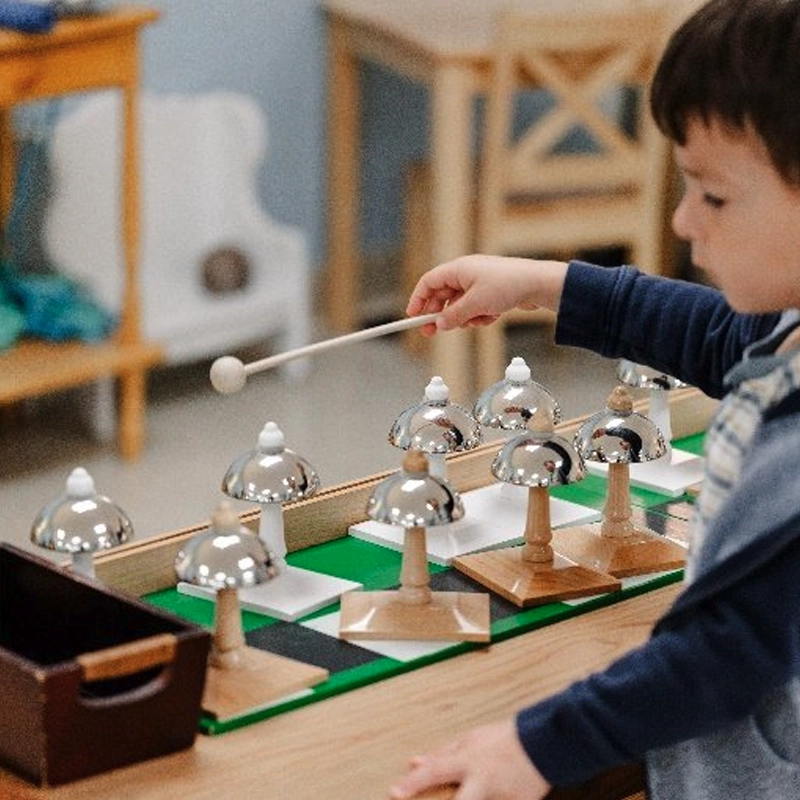
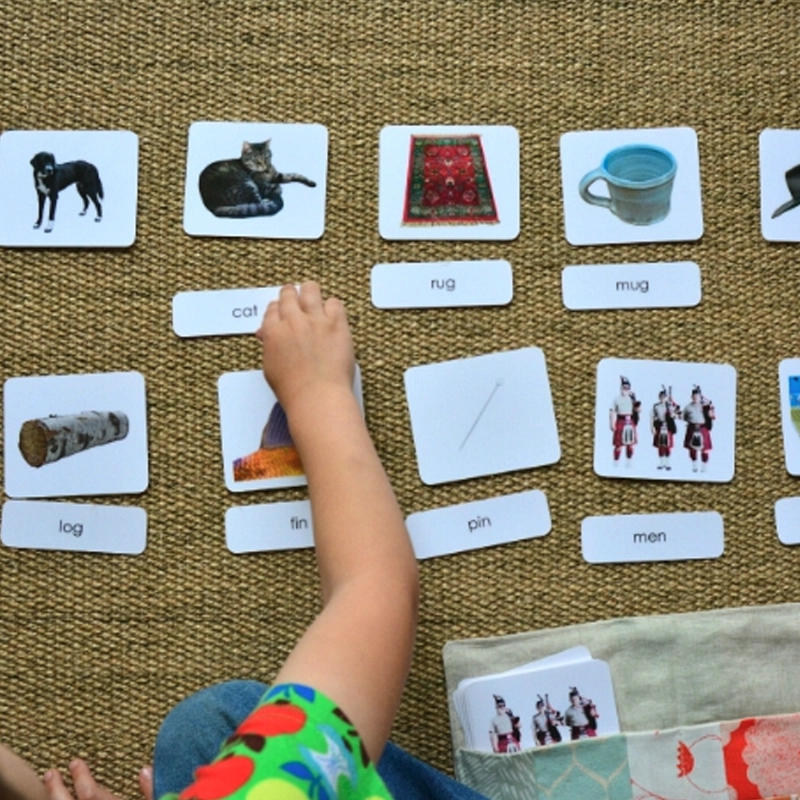
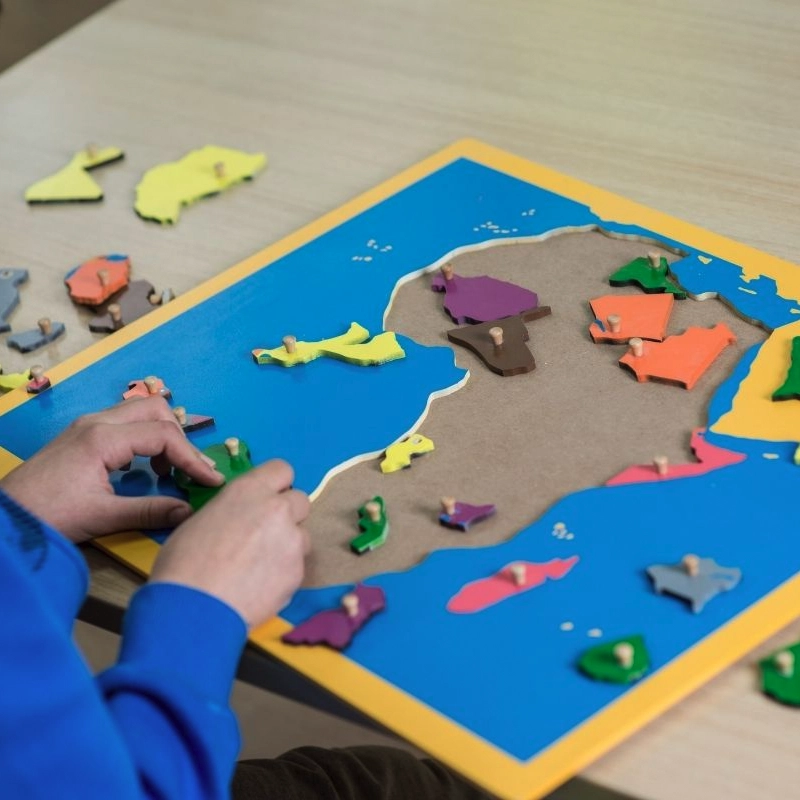
Rolle des Pädagogen: Beobachtung, Anleitung und Lehrertools
In der Montessori-Methode ist der Lehrer kein traditioneller Ausbilder mehr, sondern ein sorgfältig ausgebildeter Erwachsener. In der Montessori-Methode ist der Erwachsene im Klassenzimmer kein Dozent, sondern ein stiller Begleiter – ein aufmerksamer Beobachter, Umweltgestalter und Ruhepol. Diese Rolle ist grundlegend für den Erfolg der Methode. Montessori nannte den Erwachsenen die „dritte Komponente der vorbereiteten Umgebung“.
Gestaltung der Lernatmosphäre: Lehrkräfte als Umgebungsarchitekten
Montessori-Pädagogen sind für die tägliche Vorbereitung des Unterrichts verantwortlich und stellen sicher, dass jedes Element Unabhängigkeit, Entdeckungsfreude und Konzentration fördert. Im Gegensatz zu traditionellen Umgebungen, in denen Lehrer das Tempo und den Inhalt bestimmen, gestalten Montessori-Pädagogen Räume, in denen die Umgebung vermittelt.
Wichtige Tools für die Einrichtung im Lehrbereich
- Niedrige Lagerwagen mit abschließbaren Schubladen für wechselnde Materialien und Unterrichtsorganisation
- Demonstrationstabletts: saubere, neutral getönte, segmentierte Tabletts zur Präsentation neuer Konzepte
- Einstellbare Beleuchtung und Anzeigetafeln zur Hervorhebung der vorgestellten Materialien
- Montessori-Beobachtungsstühle: leichte, bewegliche Sitzgelegenheiten für Lehrer, um mobil und diskret zu bleiben
Diese Gegenstände helfen dem Erwachsenen, den Unterrichtsfluss aufrechtzuerhalten, ohne unnötige Aufmerksamkeit zu erregen, die Autonomie der Lernenden zu bewahren und gleichzeitig den Fortschritt subtil zu lenken.
Beobachtung als primäre Methode des Pädagogen
In der Montessori-Methode ist Beobachtung nicht passiv, sondern eine erlernte Fähigkeit. Montessori-Lehrer nutzen sie, um Daten über die Interessen, Empfindlichkeiten, Bereitschaft und soziale Dynamik der Schüler zu sammeln.
Wichtige Beobachtungstools
- Tägliche Beobachtungsprotokolle (digital oder auf der Zwischenablage) zur Verfolgung von Arbeitszyklen
- Farbcodierte Aktivitätszähler zur Überwachung der Materialverwendungshäufigkeit
- Kleine Stecktafeln oder Aktivitätstabellen zur Anzeige der Studierendenauswahl (ohne öffentliches Ranking)
- Schallgedämpfte Planungsecken zur ruhigen Wiederholung und Unterrichtsplanung während des Arbeitszyklus
Diese Tools ermöglichen es Lehrern, die Umgebung anzupassen, anstatt das Verhalten ständig umzulenken, und verlagern so die Verantwortung von der Durchsetzung auf die Erleichterung.
Führen ohne Anweisungen: Wann man eingreifen sollte
Montessori-Pädagogen praktizieren strategische Nichteinmischung. Sie unterbrechen nur, wenn ein Kind:
- Missbraucht wiederholt Materialien
- Stört die Konzentration anderer
- Sucht Hilfe, die außerhalb ihrer Reichweite liegt
Das Ziel besteht darin, eine Selbstkorrektur zu ermöglichen. Daher sind die Materialien so konzipiert, dass Fehler ohne die Mitwirkung von Erwachsenen aufgedeckt werden.
Lehrerausbildung, die die Methode würdigt
Authentische Montessori-Klassenzimmer erfordern Erzieher, die nicht nur in Pädagogik, sondern auch in emotionaler Neutralität, Materialbeherrschung und Raummanagement geschult sind.
Grundlagen der beruflichen Weiterentwicklung
- Material-Trainingspakete mit Unterrichtssequenzen und Handhabungsanleitungen
- Module zur Klassenführung mit Schwerpunkt auf Stille, Ton und Bewegung
- Peer-Observation-Modelle: Ermöglichen den Guides, die Klassenzimmer der anderen zu besuchen
- Anleitungen zur Möbelnutzung: zeigen, wie Regale, Stühle und Matten gezielt platziert werden
Schulen können die Schulung unterstützen, indem sie im Rahmen des Onboarding-Prozesses Marken-Speichersysteme, mobile Demo-Wagen und anpassbare Regaleinheiten anbieten.
Montessori für alle Kinder: Neurodiversität, Autismus und ADHS berücksichtigen
Die Montessori-Pädagogik ist keine Methode, die Unterschiede toleriert – sie ist ein System, das grundsätzlich darauf ausgerichtet ist, diese zu respektieren. Im Mittelpunkt der Montessori-Methode steht der tiefe Glaube an die Einzigartigkeit der Entwicklung jedes Kindes. Dies macht sie zu einem der neurologischsten und entwicklungsinklusivsten Bildungskonzepte, die heute verfügbar sind.
Menschliche Neigungen und das universelle Kind
Maria Montessori glaubte, dass alle Kinder, unabhängig von ihren Fähigkeiten, von universellen Tendenzen geleitet werden – wie dem Bedürfnis zu erforschen, zu ordnen, sich zu orientieren und zu wiederholen. Bei Kindern mit Autismus oder ADHS können sich diese Tendenzen anders äußern, sind aber nicht weniger ausgeprägt oder ausgeprägt.
In traditionellen Systemen wird Divergenz als Störung angesehen. In Montessori-Umgebungen wird sie als Variation innerhalb eines natürlichen Musters angesehen, nicht als Abweichung davon.
Die vorbereitete Umgebung als Regulator des Nervensystems
Montessori-Klassenzimmer sind bewusst als sensorisch integrierte Ökosysteme konzipiert. Für neurodivergente Lernende sind solche Umgebungen nicht nur vorteilhaft – sie sind unerlässlich. Montessoris strukturierte, ruhige, visuelle Klarheit und selbstbestimmte Lerngeschwindigkeit bieten Kindern, deren Gehirne anders Input verarbeiten, direkte Unterstützung.
Schlüsselelemente, die die Regulierung unterstützen:
- Materialisolierung: Nur eine Variable pro Aktivität reduziert die kognitive Überlastung
- Ordnung und Vorhersehbarkeit: Materialien sind immer am selben Ort, in der richtigen Reihenfolge
- Freiheit mit Grenzen: Kinder wählen Arbeit, aber innerhalb eines kuratierten Rahmens
- Räumliche Neutralität: Möbel, Licht und Regale folgen einem gleichmäßigen, wohltuenden Rhythmus
Dabei handelt es sich nicht um zufällige Merkmale, sondern um gezielte Unterstützung der bei ADHS häufig auftretenden Probleme mit der Exekutivfunktion und der bei Autismus häufig auftretenden Empfindlichkeiten bei der sensorischen Verarbeitung.
Unsere Möbellinien unterstützen diese Ziele mit niedrigen offenen Regalen, Arbeitsteppichen in neutralen Farbtönen und Möbeln in Kinderhöhe, die die Autonomie der Kinder respektieren.
Montessoris Entwicklungslogik und das Kind mit Autismus
Kinder mit Autismus erleben die Welt oft mit erhöhter Intensität und tiefer Konzentration. Montessoris Materialien fördern intensive Konzentration ohne Unterbrechung. Wiederholung wird nicht unterbunden, sondern begrüßt.
Der absorbierende Geist, ein zentrales Montessori-Konzept, ist besonders relevant: Neurodiverse Kinder nehmen ihre Umgebung mit großer Sensibilität auf. So wird jedes Detail des Klassenzimmers in Ton, Struktur, Rhythmus und Raum lehrreich.
Tools wie strukturierte Sequenzierungstabletts, Aufgabenerledigungskarten und bildliche Schritte helfen dabei, abstrakte Aufgaben in überschaubare, logische Teile zu unterteilen.
Montessori und ADHS: Handlungsfähigkeit als Intervention
Kinder mit ADHS haben oft Schwierigkeiten in Situationen, in denen Bewegung bestraft und Kontrolle nach außen delegiert wird. Montessori dreht das um: Von den Kindern wird erwartet, dass sie sich bewegen, Entscheidungen treffen und ihr Lernen selbst steuern.
Dies fördert die interne Regulierung, also genau die exekutive Funktion, die bei ADHS-Interventionen häufig im Fokus steht. Darüber hinaus bauen eingebettete Routinen – vom Aufrollen der Matten bis zum Ersetzen von Materialien – das prozedurale Gedächtnis auf und fördern die Aufmerksamkeit.
Leichte Klassenraum-Organizer, Aufgabenjournale und Auswahltafeln helfen dabei, den Fluss aufrechtzuerhalten und gleichzeitig für Ordnung zu sorgen.
Begleiter, keine Korrektoren: Erwachsene in neurodiversen Klassenräumen
Montessori-Erwachsene beobachten, anstatt zu befehlen. Das ist nicht passiv, sondern präzise. In neurodiversen Umgebungen wird der Erwachsene zum therapeutischen Beobachter, der die Umgebung anpasst, bevor er das Kind verändert.
Die Schulung solcher Guides sollte Folgendes umfassen:
- Verständnis der Entwicklungsneuropsychologie
- Praktische Erfahrungen mit multisensorischer Differenzierung
- Fähigkeit, den Unterrichtsraum und die Materialentwicklung als primäre Werkzeuge zu nutzen, nicht verbale Korrektur
Unser Montessori-Inklusions-Toolkit umfasst nicht nur Materialanpassungen, sondern auch Pädagogenprotokolle und Beobachtungsvorlagen für neurodiverse Lernende.
Ein System, das dem Kind vertraut
In einer Montessori-Klasse wird das Kind mit Autismus nicht darauf trainiert, sich anzupassen – es wird eingeladen, sich zu entfalten. Das Kind mit ADHS wird nicht unterdrückt – es wird befähigt, seinen Rhythmus zu bestimmen. Dies ist kein Klassenzimmer, das sich anpasst – es ist ein Klassenzimmer, das bereits auf Vielfalt ausgelegt ist.
Montessori ist nicht nur inklusiv. Es ist von Natur aus inklusiv. Es ist keine Lösung für Neurodiversität – es ist eine Reaktion auf die menschliche Verfassung.
Warum die Montessori-Methode wählen: Praktische Auswirkungen für Pädagogen und Lernräume
Bei der Montessori-Methode geht es nicht nur um die Einführung eines anderen Lehrplans – es geht um eine Neugestaltung der Bildungsarchitektur. Für Pädagogen und Schulleitungen bedeutet dies messbare Verbesserungen im Unterrichtsablauf, im Engagement der Lehrkräfte und in den Lernergebnissen der Schüler. Erfahren Sie, wie diese Methode Lernumgebungen spürbar und nachhaltig verändert.
1. Arbeitszyklen: Tiefenfokus und Flow fördern
In Montessori-Klassenzimmern wird in ununterbrochenen Arbeitszyklen von 2–3 Stunden gearbeitet. Diese Struktur ermöglicht es den Kindern, sich stärker zu konzentrieren, fließend zwischen den Themenbereichen zu wechseln und selbstbestimmte Fortschritte zu machen.
Auswirkungen auf Lernräume:
- Benötigt Materialrotationssysteme, um das Interesse der Schüler aufzufrischen und sie herauszufordern
- Benötigt mobile Demostationen, um neue Materialien effizient einzuführen
- Fordert Klassenpläne oder Stundenpläne als Referenz für die Schüler
Produktlösungen:
- Modulare Regaleinheiten auf Rollen für eine einfache Materialrotation
- Robuste Demonstrationstische mit Feststellrollen
- Magnetische visuelle Terminplantafeln, die die Unabhängigkeit fördern
2. Auswahl innerhalb eines Rahmens: Das richtige Gleichgewicht
Montessori unterstützt Kinder dabei, echte Entscheidungen zu treffen, diese werden jedoch immer angeleitet. Lernräume müssen dieses Gleichgewicht widerspiegeln: Sie müssen sicher und strukturiert sein, aber dennoch genügend Freiraum für Selbstbestimmung bieten.
Auswirkungen auf den Weltraum:
- Materialien sind sichtbar, aber nicht überwältigend
- Präzise Abgrenzung jedes Arbeitsbereichs
- Zonen für ruhiges Arbeiten, Kleingruppen und Bewegung
Produktlösungen:
- Niedrige Trennwände, die Bereiche optisch abgrenzen, ohne die Sicht zu beeinträchtigen
- Transparente Behälter und Schalen, die den Inhalt deutlich anzeigen
- Teppichsets in der Größe für Einzel- und Gruppenbereiche, die den persönlichen Arbeitsbereich markieren
3. Der Fluss des Erwachsenen: Vom Ausbilder zum Bediener
In der Montessori-Schule wechseln die Lehrer nicht zwischen Tischen und Tafeln – sie bewegen sich bewusst und agieren eher als Umfeldgestalter denn als Dozenten. Dieser Fluss wird durch gezielte Gestaltung unterstützt.
Betriebsanforderungen:
- Erwachsene benötigen diskrete Transportstationen für Unterrichtsmaterialien
- Ein einheitliches Layout, das nahtlose Bewegung ohne Gedränge ermöglicht
- Beobachtungsunterstützende Tools, die ohne Unterrichtsunterbrechung eingesetzt werden können
Produktlösungen:
- Lehrer schieben Wagen mit verschließbaren Behältern für den Unterrichtswechsel
- Beobachtungsstationen mit Klemmbrettern und in Regalen integrierten Sitzgelegenheiten
- Tragbare Demonstrationstabletts, die als Miniatur-Lehrerpulte fungieren
4. Reichhaltige, wechselnde Materialien = ständiges Engagement
Ein Kennzeichen eines erfolgreichen Montessori-Raums ist ein Regal, das täglich neu gestaltet wird. Lehrer müssen Materialien einführen, austauschen und wieder aussortieren, um die Motivation aufrechtzuerhalten und dem Entwicklungsfortschritt gerecht zu werden.
Implementierungsstrategien:
- Führen Sie eine Bestandskarte, um die Materialplatzierungen zu verfolgen
- Bereiten Sie Backup-Kits für die gleichzeitige Verwendung vor
- Richten Sie die Materialanzeige an aktuellen Unterrichtsthemen oder neuen Interessen aus.
Produktlösungen:
- Farbcodierte Tabletts für verschiedene Lehrplanbereiche
- Regaleinheiten mit nummerierten und beschrifteten Abschnitten zur einfachen Katalogisierung
- Ersatz-Kits sind montagefertig und sofort einsatzbereit
5. Fortschritt messen, ohne den Fluss zu unterbrechen
Montessori verlässt sich nicht auf Noten, was aber nicht heißt, dass es keine Beurteilung gibt. Fortschritte werden durch Beobachtung, Arbeitsportfolios und narrative Erkenntnisse erfasst, wofür speziell entwickelte Instrumente erforderlich sind.
Betriebsstrategien:
- Verwenden Sie digitale Protokolle oder Papierordner diskret während der Arbeitszyklen
- Ermutigen Sie Kinder, selbst Arbeitsbücher oder Portfolios zu erstellen
- Richten Sie Reflexions- oder von Schülern geleitete Präsentationsstationen ein
Produktlösungen:
- Nachfüllbare Portfolio-Ordner mit transparenten Hüllen
- Digitale Klemmbretter und Tablets werden in Lehrerwagen aufbewahrt
- Reflexionsstationen mit Hinweisen, Lichtern und Pinnwänden
Alles zusammen: Ihr Klassenzimmer auf einem höheren Niveau
Jeder Montessori-Klassenraum ist ein lebendiges System. Von Möbeln und Zonen über Materialien bis hin zum Lernfluss prägt jedes Detail den Lernprozess. Deshalb geht unser Angebot über einzelne Elemente hinaus – wir bieten abgestimmte Klassenraum-Sets, von Designern erstellte Grundrisspläne und kontinuierliche operative Unterstützung.
Wenn Sie in unsere Montessori-Klassenzimmerlösung investieren, kaufen Sie nicht nur Möbel oder Materialien – Sie erhalten Zugriff auf ein entwickeltes Ökosystem, das darauf ausgelegt ist, tiefgreifendes Lernen zu unterstützen, den Verwaltungsaufwand zu reduzieren und ein kontinuierliches, kindgerechtes Wachstum zu fördern.
Ihr perfektes Klassenzimmer ist nur einen Klick entfernt!
Wie die Montessori-Methode die traditionelle Bildung übertrifft
Eltern und Erzieher fragen oft: „Wie schneidet die Montessori-Methode im Vergleich zur traditionellen Bildung wirklich ab?“ Obwohl beide darauf abzielen, Entwicklung und Lernen zu fördern, unterscheiden sich ihre zugrunde liegenden Philosophien, Unterrichtserfahrungen und langfristigen Ergebnisse erheblich.
In diesem Abschnitt wird ein direkter, forschungsgestützter Vergleich wichtiger Bildungsdimensionen vorgenommen.
Montessori vs. traditionelle Bildung: Ein klarer Vergleich
| Dimension | Montessori-Methode | Traditionelle Bildung |
|---|---|---|
| Lernansatz | Von Kindern geleitete, interessengesteuerte Erkundung | Lehrergeleiteter Unterricht, fester Lehrplan |
| Rolle des Lehrers | Führer und Beobachter; unterstützt die Autonomie | Lehrer und Autorität; vermittelt Wissen |
| Klassenzimmergestaltung | Vorbereitete Umgebung mit kindgerechten Materialien, Bewegungsfreiheit | Tische in Reihen, Lehrer vorne |
| Bewertungsstil | Beobachtungsaufzeichnungen, Portfolios, kompetenzbasierter Fortschritt | Standardisierte Tests, Noten, Ranking |
| Lehrplanflexibilität | Angepasst an das Tempo und die sensible Phase jedes Kindes | Gleicher Inhalt, gleiches Tempo, altersgerechte Vermittlung |
| Entwicklungsschwerpunkt | Ganzheitlich: sozial, emotional, körperlich, intellektuell | Vorwiegend akademisch |
| Zusammenarbeit | Förderung durch altersgemischte Klassen und Peer-Teaching | Begrenzt; altershomogene Gruppen reduzieren Mentoring-Möglichkeiten |
| Disziplin | Innere Regulierung und natürliche Folgen | Externe Disziplin und Belohnungen/Bestrafungen |
| Verwendung von Materialien | Praktische, didaktische Materialien zur Unterstützung des multisensorischen Lernens | Hauptsächlich Lehrbücher und digitale Bildschirme |
Was die Forschung sagt
Studien zeigen, dass Montessori-Schüler:
- Zeigen ein höheres Maß an exekutiven Funktionen (Aufmerksamkeit, Selbstkontrolle)
- Zeigen Sie eine stärkere intrinsische Motivation und akademische Neugier
- Zeigen Sie eine fortgeschrittenere soziale Wahrnehmung und kollaboratives Verhalten
- Erzielen Sie gleichwertige oder bessere akademische Leistungen ohne formellen Prüfungsdruck
Eine Studie aus dem Jahr 2006, veröffentlicht in Wissenschaft fanden heraus, dass Montessori-Schüler im Alter von fünf Jahren in den Bereichen Lesen, Mathematik und Sozialkompetenz deutlich bessere Ergebnisse erzielten als Gleichaltrige in traditionellen Umgebungen.
Montessori in Aktion: Greifbare Unterschiede für Pädagogen und ElternS
Im Folgenden erfahren Sie, was diese Unterschiede in echten Klassenzimmern und zu Hause bedeuten:
- Lehrer brauchen flexible Regale, bewegungsfreundliche Layouts und Beobachtungstools statt Whiteboards und starrer Unterrichtspläne.
- Eltern Wer konsequent auf die Entwicklung seiner Unabhängigkeit hinarbeiten möchte, benötigt leicht zugängliche Möbel, echtes Kinderwerkzeug und sensorische Kits.
Unsere Produktsets für den Unterricht – das Freedom-Focused Layout Kit, Didactic Material Essentials und das Behavior-Through-Design Toolkit – sind darauf ausgelegt, diese Transformation Wirklichkeit werden zu lassen.
Was das für Sie bedeutet
Wenn Sie die Einheitspädagogik satt haben, bietet Montessori nicht nur eine Methode, sondern auch eine Denkweise und Werkzeuge, die diese unterstützen. Bei diesem Vergleich geht es nicht um Überlegenheit. Es geht um die Ausrichtung: die Ausrichtung des Unterrichts auf Gehirn, Körper und Seele des Kindes.
Die Entscheidung für Montessori bedeutet die Entscheidung für:
- Weniger Kontrolle, mehr Vertrauen
- Weniger Vorlesungen, mehr Lernen
- Nicht mehr Lärm, sondern mehr Fokus
- Keine starren Systeme, sondern vorbereitete, zielgerichtete Freiheit
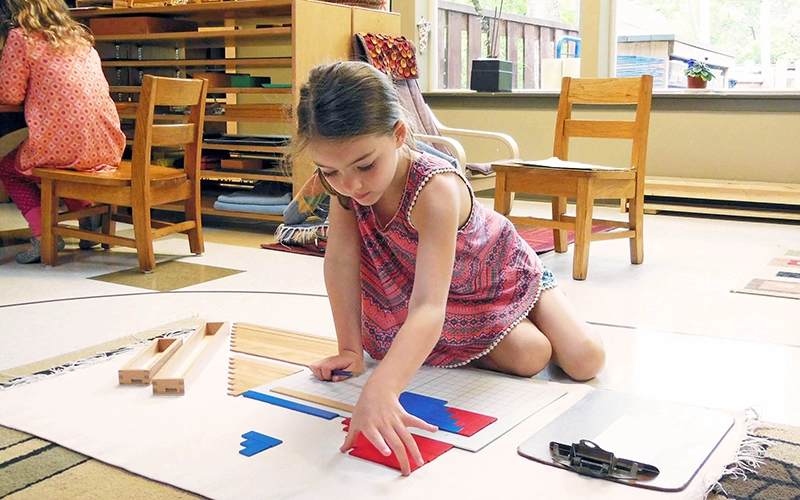

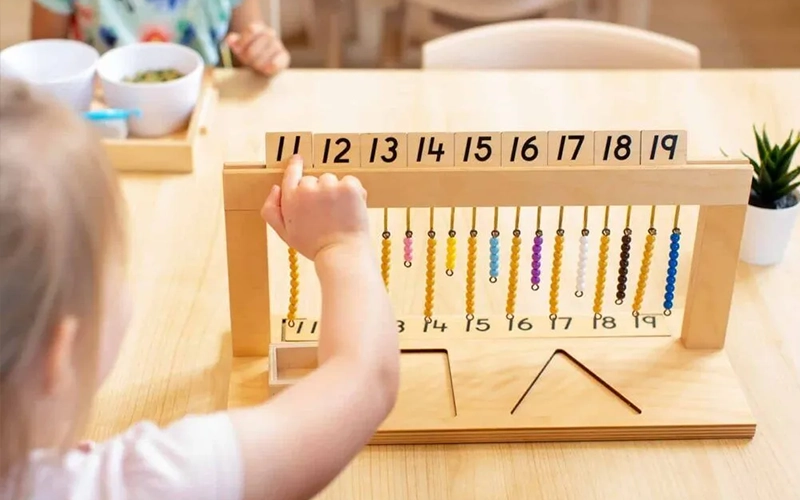
So wenden Sie Montessori zu Hause an
Um Ihr Zuhause in eine Mini-Montessori-Umgebung zu verwandeln, benötigen Sie kein komplettes Klassenzimmer – es braucht nur Zielstrebigkeit, Struktur und sorgfältig ausgewählte Hilfsmittel. Diese Schritte helfen Ihnen, die Montessori-Prinzipien so umzusetzen, dass Unabhängigkeit, Ausgeglichenheit und natürliches Lernen im familiären Umfeld gefördert werden.
1. Planen Sie Ihre Montessori-Heimumgebung
Auch in kleinen Räumen ist die Raumaufteilung wichtig. Identifizieren Sie drei Kernbereiche:
- Selbstpflegezone – Ein niedriges Regal für Kleidung, ein Hocker in Kindergröße zum Zähneputzen und Spiegel auf Augenhöhe.
- Praktische Lebenszone – Ein Tablett mit authentischem Geschirr, Stofffaltutensilien und Bürsten-/Reinigungsmaterialien.
- Lernzone – Ein kleiner Tisch oder Bodenmatten für sensorische, literarische und numerische Aktivitäten.
Tipps für kompakte Häuser:
- Verwenden Sie rotierende Körbe anstelle von festen Regalen.
- Verwenden Sie Möbel um – senken Sie einen Couchtisch ab oder bringen Sie kinderfreundliche Zugangsstangen an Schränken an.
- Kombinieren Sie Zonen, wo nötig, um unübersichtliche Übergänge zu vermeiden.
2. Wählen Sie Materialien langsam und bewusst aus
Montessori zu Hause bedeutet Qualität vor Quantität. Beginnen Sie mit drei oder vier gut gemachten, zweckmäßigen Materialien, die auf die Entwicklungsphase Ihres Kindes abgestimmt sind, und erweitern Sie diese dann nach und nach.
Empfohlene Starter-Sets:
- Echtes Bestecktablett: Messer, Gabel, Salzstreuer – unterstützt die Unabhängigkeit bei den Mahlzeiten.
- Kleines Sensorik-Set: Farbtabletten oder strukturierte Objekte zum Sortieren.
- Bewegliches Alphabet: Karten für Phonetik und frühes Schreiben.
Bewahren Sie die Materialien geordnet auf einem niedrigen Regal auf. Wenn Ihr Kind bereit ist, wechseln Sie die Materialien oder integrieren Sie neue in kleinen Schritten, um eine Überforderung zu vermeiden.
3. Strukturieren Sie einen einfachen Rhythmus, keinen vollen Zeitplan
Vermeiden Sie starre Routinen. Führen Sie stattdessen einen Morgenrhythmus wie diesen ein:
- Frühstück → Selbstfürsorge
- „Arbeitszeit“ (30–60 Minuten)
- Gemeinsam reflektieren (z. B. Tagebuch führen, Geschichten teilen)
- Kreative Zeit im Freien oder unstrukturierte Zeit
Das Ziel ist der Flow – das Aufbauen von Phasen der Unabhängigkeit ohne überwältigende Struktur.
4. Seien Sie ein Vorbild für friedliches Engagement und Respekt
In der Montessori-Pädagogik sind Erwachsene eher Vorbilder als Lehrer. Sitzen Sie während der „Arbeitszeit“ ruhig bei Ihrem Kind und demonstrieren Sie Konzentration und Ruhe – die ultimative Einladung zur Unabhängigkeit.
Vermeiden Sie lobende oder direktive Sprache. Erzählen Sie stattdessen neutral:
„Ich sehe, Sie ordnen die Farben.“
Dieser Ansatz fördert eher das Gefühl der Handlungsfähigkeit als das der Urteilsbildung.
5. Beobachten, reflektieren und anpassen
Beobachtung ist der Motor des Montessori-Ansatzes – UND Ihrer Erziehung. Unterbrechen Sie die Konzentration nicht, sondern machen Sie sich Notizen zu:
- Welche Gegenstände ziehen Ihr Kind an?
- Wie gehen sie mit Frustration oder Erfolg um?
- Wiederholen sie bestimmte Aufgaben häufiger?
Diese Hinweise dienen als Leitfaden für die zukünftige Materialauswahl und Umweltoptimierungen.
Montessori Schritt für Schritt ins Zuhause bringen
Die Umstellung Ihres Zuhauses auf eine Mini-Montessori-Umgebung kann folgendermaßen aussehen:
✓ Woche 4 und darüber hinaus: Beobachten, anpassen, Materialien austauschen und Ordnung halten.
✓ Woche 1: Einführung der Selbstpflegezone.
✓ Woche 2: Fügen Sie Tabletts für das praktische Leben hinzu und laden Sie zur eigenständigen Nutzung ein.
✓ Woche 3: Wechseln Sie je nach den Interessen Ihres Kindes zwischen einer sensorischen oder Lese- und Schreibaktivität.
Vorteile & Nachteile: Ein ausgewogener Blick mit Lösungen
Die Montessori-Methode bietet zwar transformative Vorteile, doch kein pädagogischer Ansatz ist ohne Herausforderungen. Hier präsentieren wir eine differenzierte Bewertung – mit Schwerpunkt auf Stärken und Bereichen, die noch verbessert werden müssen – und bieten gleichzeitig klare Lösungen und Produktunterstützung, um etwaige Lücken zu schließen.
Vorteile der Montessori-Methode
- Fördert tiefe Konzentration
Die Kinder nehmen an ununterbrochenen Arbeitszyklen teil und entwickeln dadurch eine Konzentration, die weit über das hinausgeht, was in herkömmlichen Klassenzimmern üblich ist. - Fördert Unabhängigkeit und Verantwortung
Der Zugang zu kindgerechten Möbeln und grundlegenden Werkzeugen befähigt Kinder, Entscheidungen zu treffen, Aufgaben zu Ende zu führen und sich um ihre Umgebung zu kümmern. - Unterstützt individualisiertes Lernen
Im Gegensatz zu altersbasierten Lehrplänen basiert die Methode darauf, die Bereitschaft und Interessen jedes einzelnen Kindes zu beobachten und darauf einzugehen. - Fördert soziale und emotionale Intelligenz
Altersgemischte Gruppen fördern Peer-Teaching, Zusammenarbeit und Empathie. - Fördert die lebenslange Liebe zum Lernen
Durch intrinsische Motivation – gefördert durch Autonomie und Meisterschaft – wird ein selbstbestimmter Weg geschaffen, der weit über die ersten Jahre hinaus anhält.
Nachteile und wie man sie behebt
| Herausforderung | Lösungsstrategie | Produkt/Anwendung |
|---|---|---|
| Wahrgenommener Mangel an Struktur für Eltern und Lehrer | Orientierungsveranstaltungen für Pädagogen und visuelle Stundenpläne zu Hause und in der Schule | Unterrichtsplanungskits; magnetische Stundenplantafeln; Elternhandbücher |
| Implementierungskosten hochwertiger Materialien | Stufenkaufpläne und zertifizierte Gebrauchtmaterialien | Günstige Starterpakete; abgestufte Unterrichtssets; Inzahlungnahmemöglichkeiten für gebrauchte Sets |
| Risiko von Inkonsistenzen ohne entsprechende Schulung | Laufende Coach-Besuche, Peer-Beobachtungen und berufsbegleitende Workshops | Schulungsabonnements; Beobachtungsprotokolle; videobasierte Mentorsitzungen |
| Kind verliert in Übergangsphasen die Konzentration | Definierte Übergangsstrategien und Übergangsstationen | Übergangsmatten; Auswahltafeln; Zeiterfassungsgeräte |
| Anpassungsschwierigkeiten bei traditionellen Schulübergängen | Hybridmodelle, narrative Assessments und methodenübergreifende Vorbereitungsphasen | Portfolio-Kits; Materialien mit Doppelfunktion, die sowohl an akademische als auch an Montessori-Umgebungen angepasst werden können |
Nachteile in Stärken verwandeln
Unsere Lösungen – speziell für Montessori-Umgebungen entwickelt – machen diese Herausforderungen beherrschbar und können mit der Zeit sogar von Nutzen sein. Zum Beispiel:
- Sichtbare Tools und Zeitpläne sorgen für Sicherheit und Klarheit, ohne Starrheit zu erzeugen.
- Durch die schrittweise Implementierung des Materials können Schulen schrittweise authentische Umgebungen aufbauen.
- Zertifizierte Schulungen und Ressourcen gewährleisten die Treue zur Methode und die Aufrechterhaltung der Qualität bei allen Pädagogen.
Diese Lösungen ermöglichen es Administratoren und Eltern, das Montessori-Lernen auch in ressourcenbeschränkten oder hybriden Umgebungen selbstbewusst zu unterstützen.
Warum diese ausgewogene Perspektive wichtig ist
Dieser Abschnitt dient nicht nur der akademischen Transparenz, sondern auch der strategischen Positionierung. Die Darstellung von Vor- und Nachteilen sowie praktischen Lösungen zeigt, dass Sie:
- Verstehen Sie die Einschränkungen der realen Welt
- Bieten Sie einen greifbaren Wert – nicht jedes Produkt, aber die richtige Werkzeuge
- Bieten Sie einen erprobten, schrittweisen Weg zur Implementierung an
- Wir setzen uns für Montessori-Authentizität und langfristigen Erfolg ein
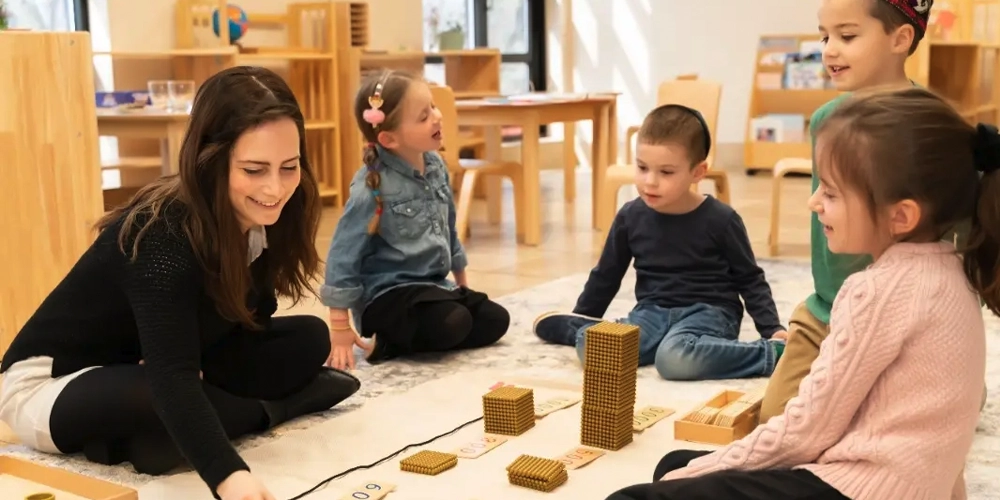
Abschluss
Die Montessori-Methode ist mehr als ein pädagogischer Ansatz – sie ist eine Philosophie der menschlichen Entwicklung. Sie würdigt die Autonomie des Kindes, seine natürliche Neugier und sein inneres Bedürfnis nach Ordnung, Sinn und Freude. Im Gegensatz zu traditionellen Systemen, die Lernen aufzwingen, fördert Montessori es durch sorgfältige Gestaltung, respektvolle Rollen der Erwachsenen und sorgfältig gestaltete Materialien.
Von vorbereiteten Umgebungen bis hin zu sensorischen Werkzeugen, von inklusiven Praktiken für neurodiverse Kinder bis hin zu praktischen Anwendungen zu Hause ist Montessori sowohl zeitlos als auch aktuell.
Für Pädagogen, Administratoren und Eltern bedeutet die Übernahme dieser Methode nicht nur, einen neuen Unterrichtsstil anzunehmen, sondern auch, ihre Sichtweise auf das, was Lernen wirklich ist, zu ändern.
Dieser Artikel ist Teil unserer Reihe zur Bildungstheorie, in der wir einflussreiche Denker untersuchen, die unsere Lehr- und Lernweise neu geprägt haben.
- Erfahren Sie mehr Jean Piagets Theorie der kognitiven Entwicklung entspricht dem selbstgesteuerten Ansatz von Montessori.
- Entdecken Lew Wygotskis soziokulturelle Theorie und wie sich die Zone der proximalen Entwicklung mit Montessoris Rahmen der sensiblen Phase überschneidet.
Zusammen helfen Ihnen diese Perspektiven nicht nur zu verstehen, was bei Montessori funktioniert, sondern auch, warum es funktioniert.
FAQs
1. Warum umfasst die Montessori-Klasse eine Altersspanne von drei Jahren?
Montessori-Klassen werden typischerweise in Gruppen von Kindern aller Altersgruppen (z. B. 3–6 Jahre) eingeteilt. So lernen jüngere Kinder durch Beobachtung älterer Mitschüler, während ältere Kinder ihr Verständnis durch die Betreuung anderer vertiefen. Diese altersübergreifende Dynamik fördert Führungsqualitäten, Empathie und gemeinsames Lernen.
2. Wie wird Disziplin in Montessori-Einrichtungen gehandhabt?
Disziplin basiert in der Montessori-Pädagogik nicht auf Belohnungen oder Bestrafungen. Stattdessen werden Kinder durch klare Erwartungen, Respekt vor Materialien und das Verständnis natürlicher Konsequenzen zur Selbstregulierung angeleitet. Lehrer greifen nur ein, wenn das Verhalten eines Kindes die Umwelt stört oder anderen schadet.
3. Wie viele Schüler sind in einer Montessori-Klasse?
Anstatt auf minimale Klassengrößen zu setzen, legen Montessori-Klassen Wert auf ein optimales Lehrer-Schüler-Verhältnis – typischerweise eine Begleitperson plus eine Assistentin für 25–30 Schüler. Das mag zwar bedeutsam erscheinen, doch die altersgemischte, selbstbestimmte Umgebung fördert eine starke soziale Dynamik und die Interaktion mit der Gemeinschaft.
4. Ist die Montessori-Pädagogik nur etwas für Privilegierte?
Montessori wurde ursprünglich für unterversorgte Kinder entwickelt, nicht für die Elite. Während die frühe Einführung in Privatschulen diesen Eindruck erweckte, hat sich die Methode weltweit verbreitet, auch in öffentlichen Einrichtungen und in einkommensschwachen Familien. Laut AMS und globalen Nutzungsstatistiken bedient sie heute eine vielfältige Bevölkerungsgruppe und legt Wert auf Zugänglichkeit statt Exklusivität.
5. Stimmt es, dass es in Montessori-Klassenzimmern „keine Regeln“ gibt?
Nein. Montessori-Klassenzimmer funktionieren nach dem Prinzip der Freiheit in GrenzenKinder können ihre Arbeit frei wählen, aber erst nach Unterricht im respektvollen Umgang mit Materialien. Das Klassenzimmerumfeld – und die Rolle des Lehrers – stellt sicher, dass Kinder Grenzen und Respekt für sich selbst, andere und Materialien verstehen.

